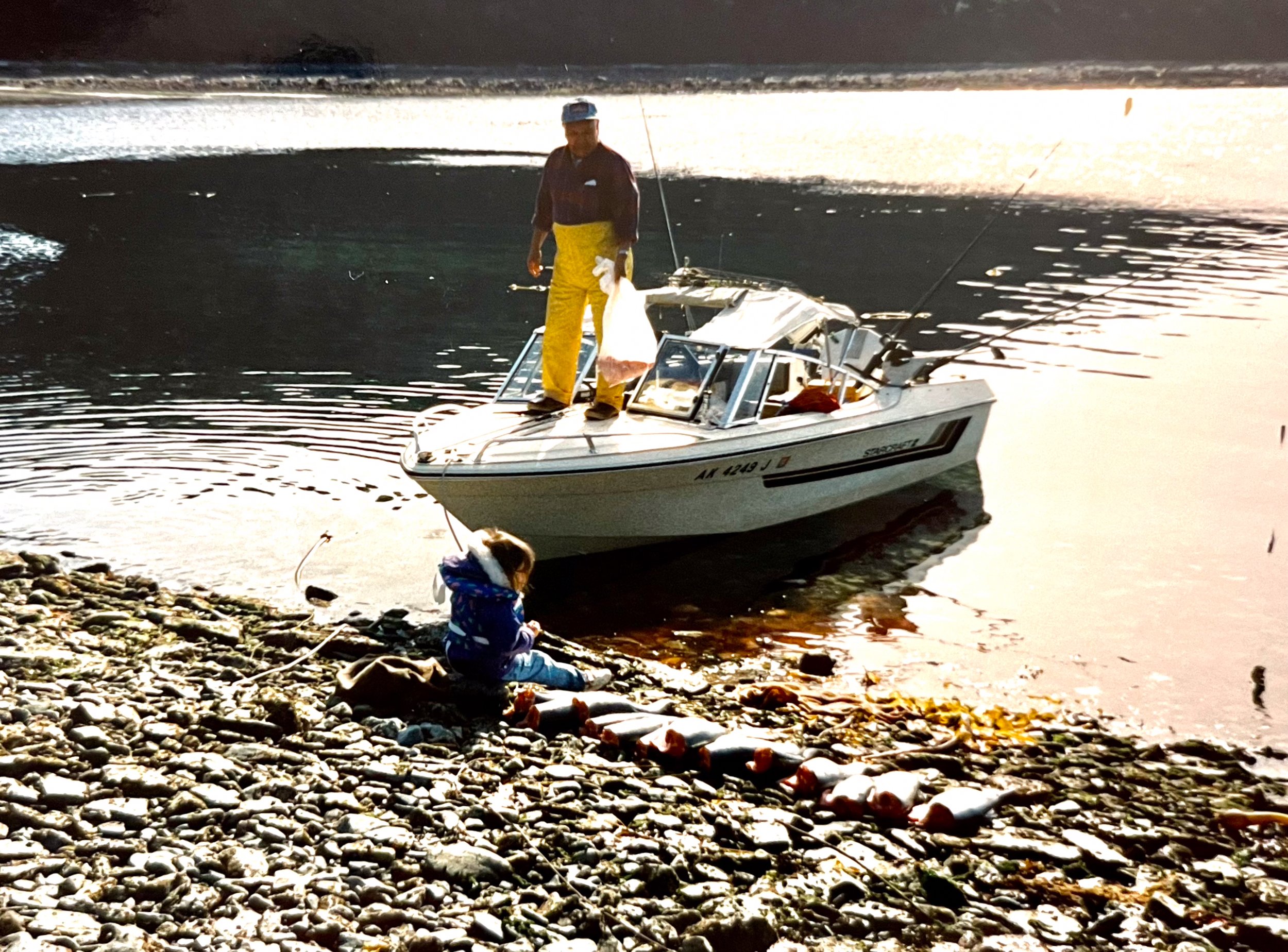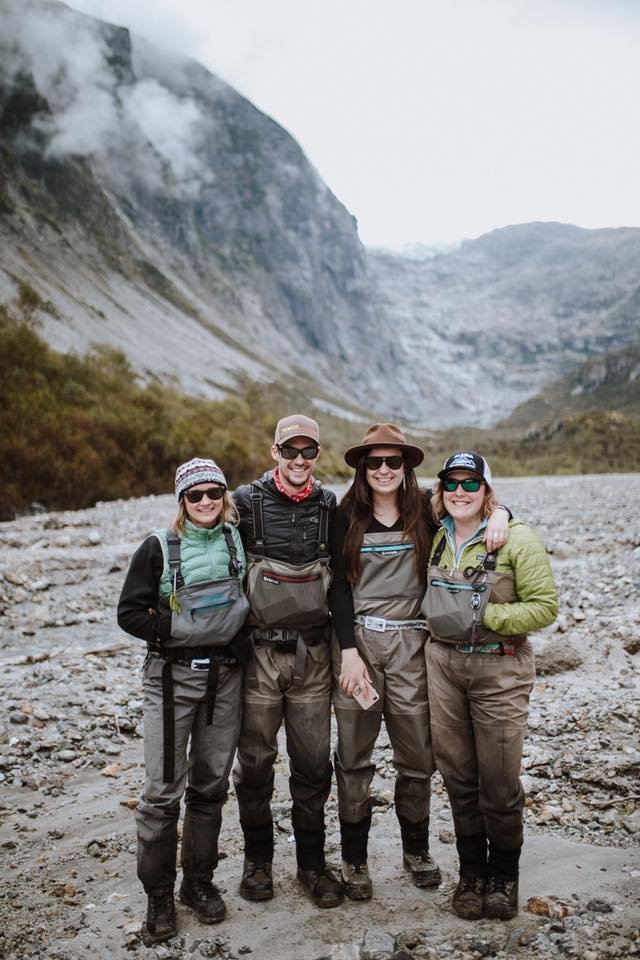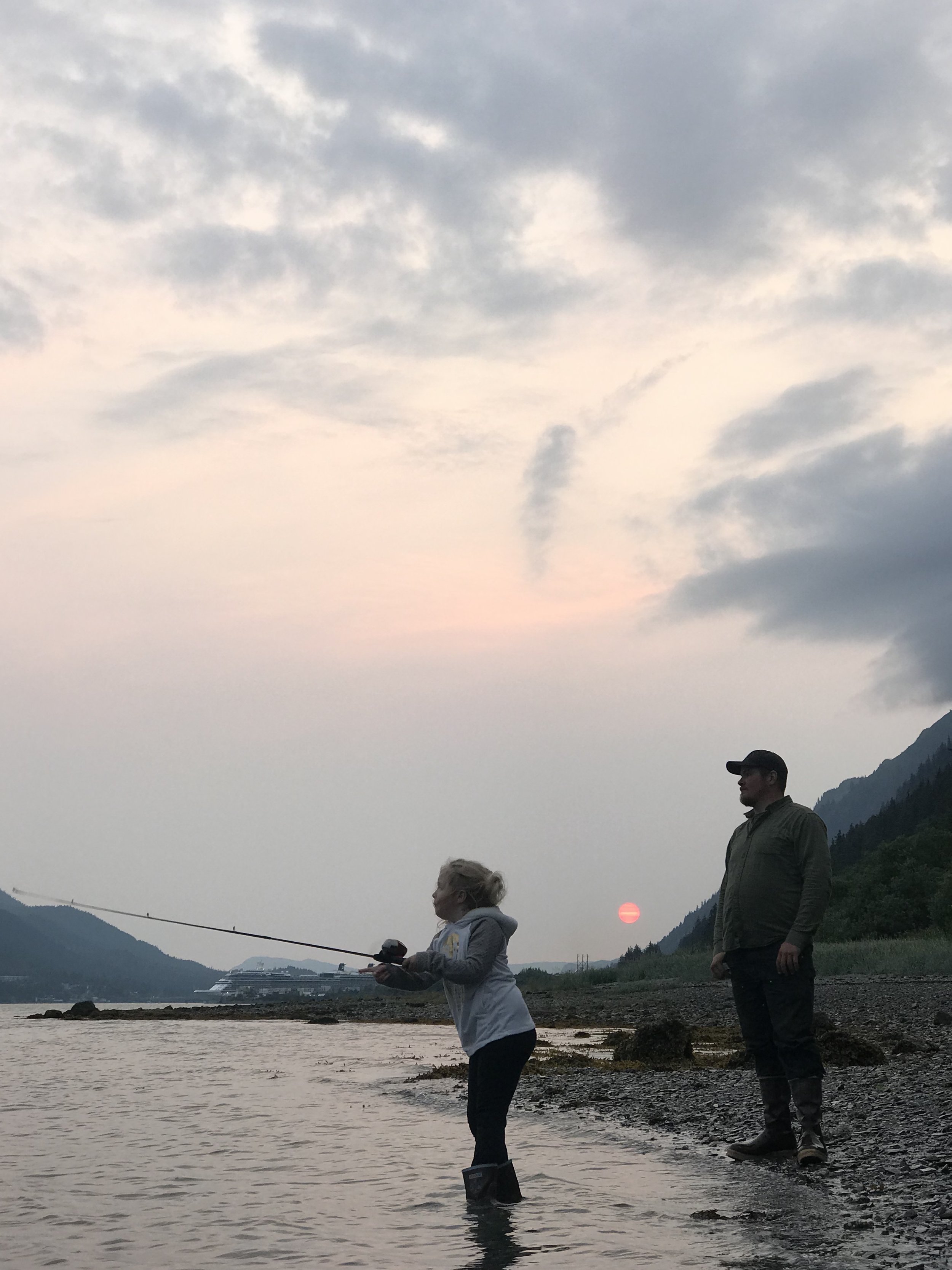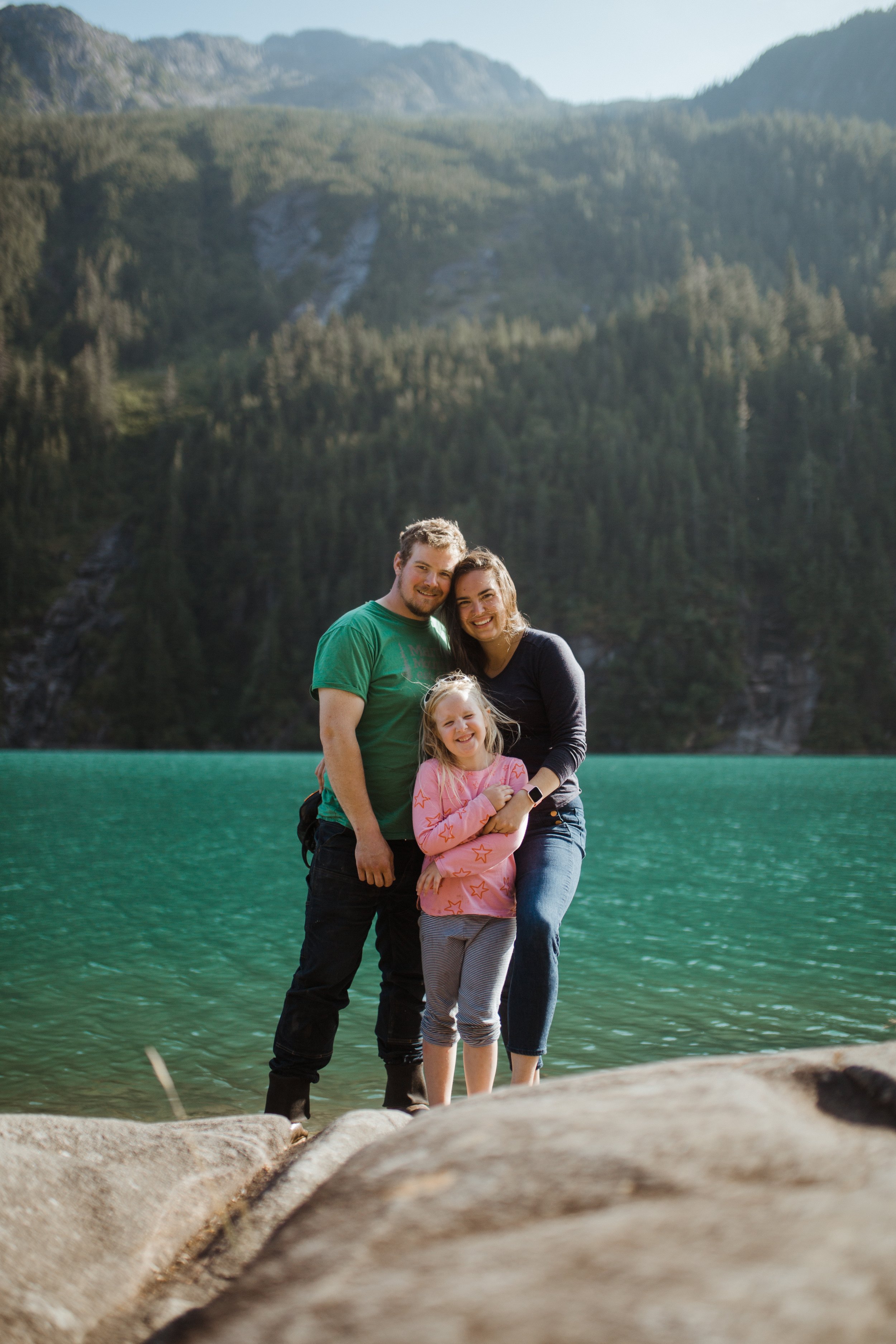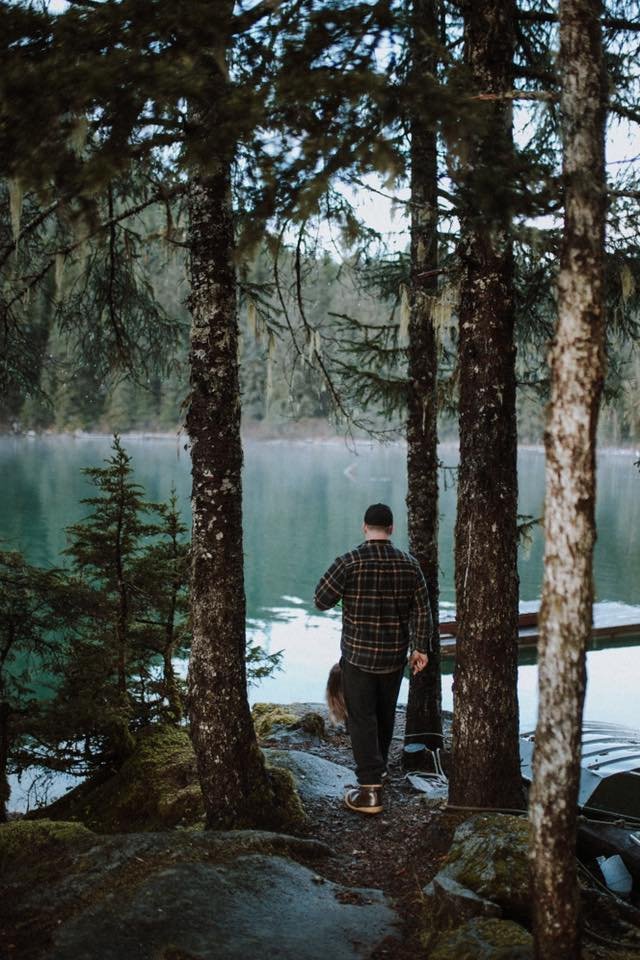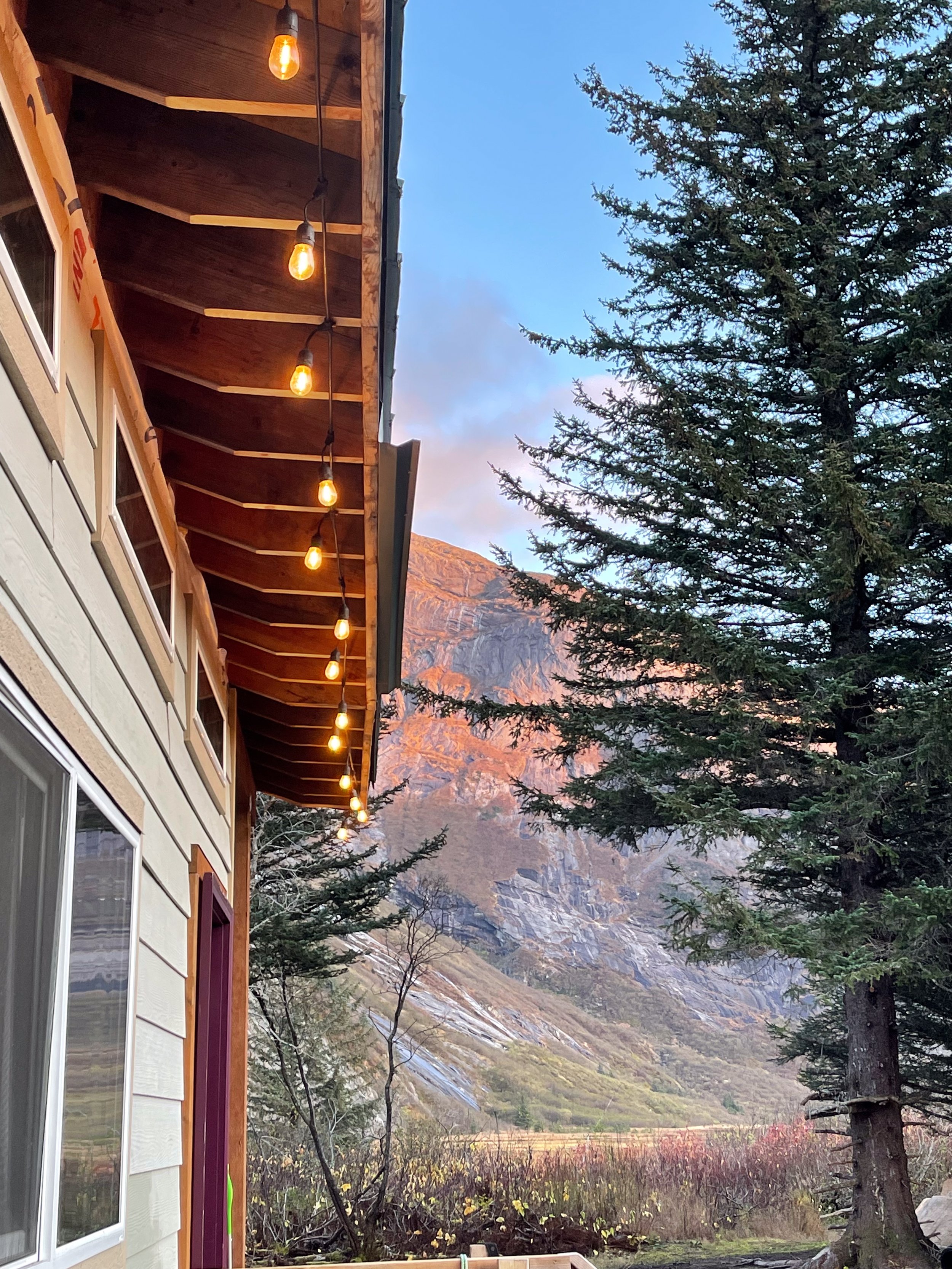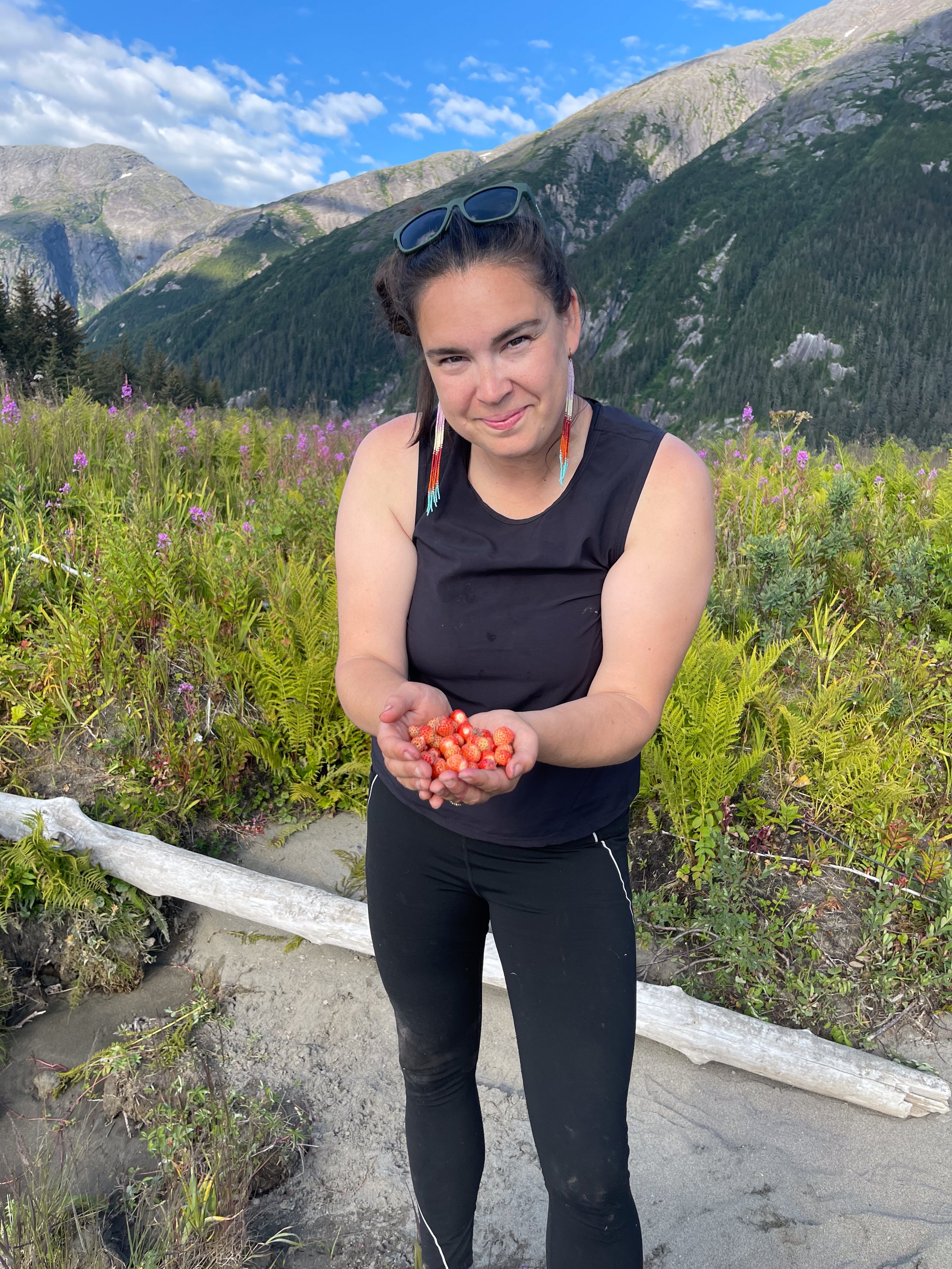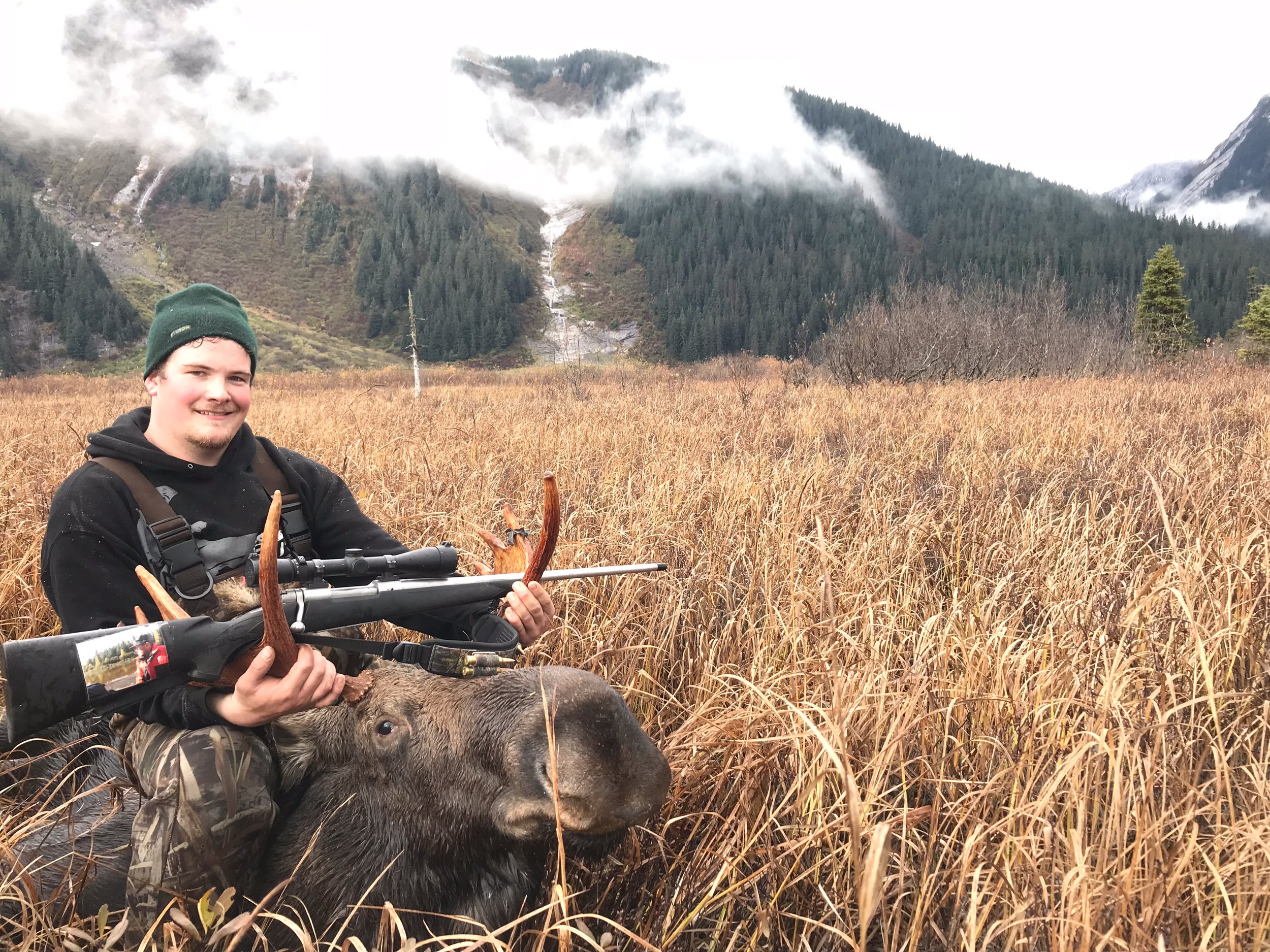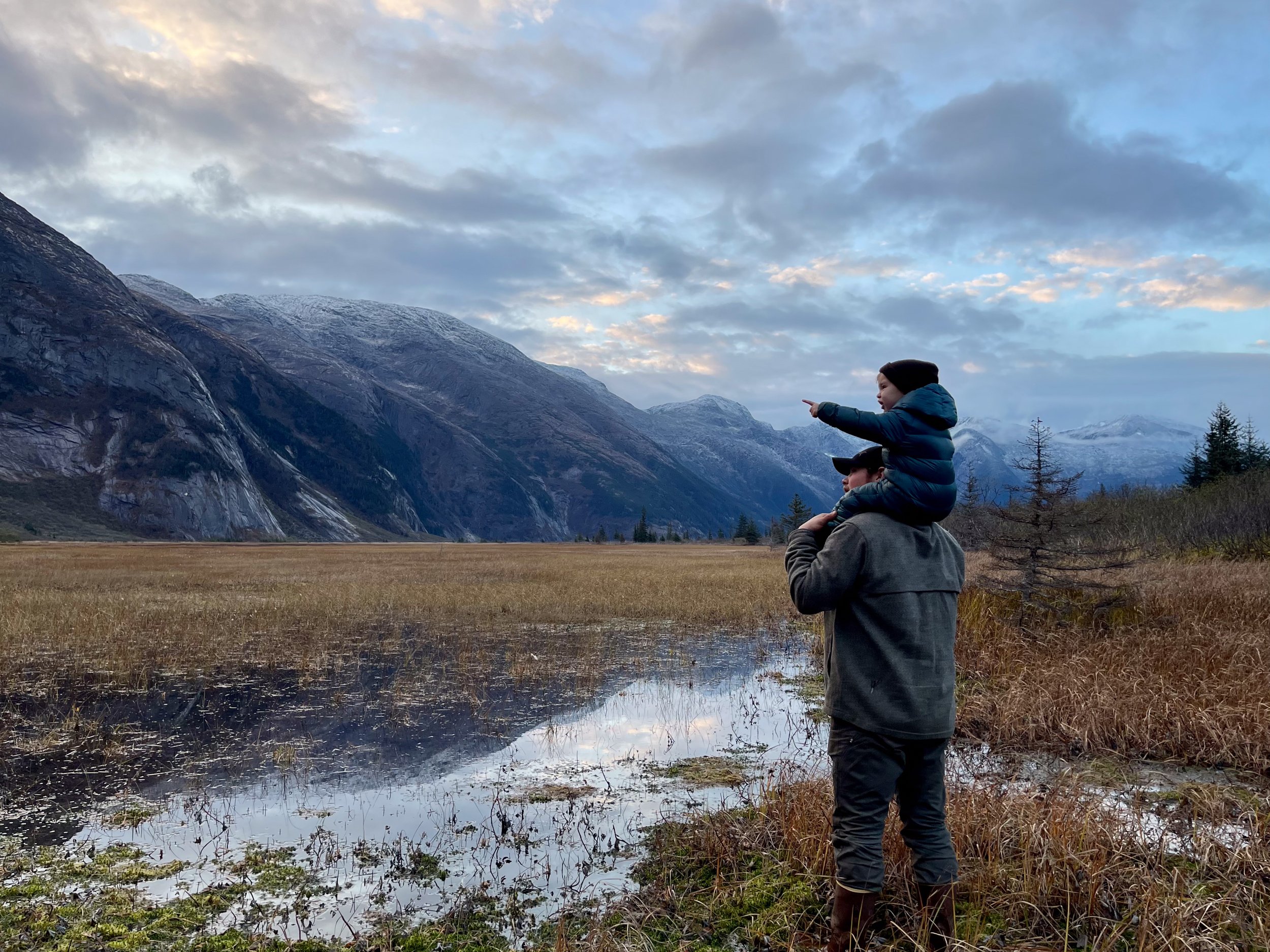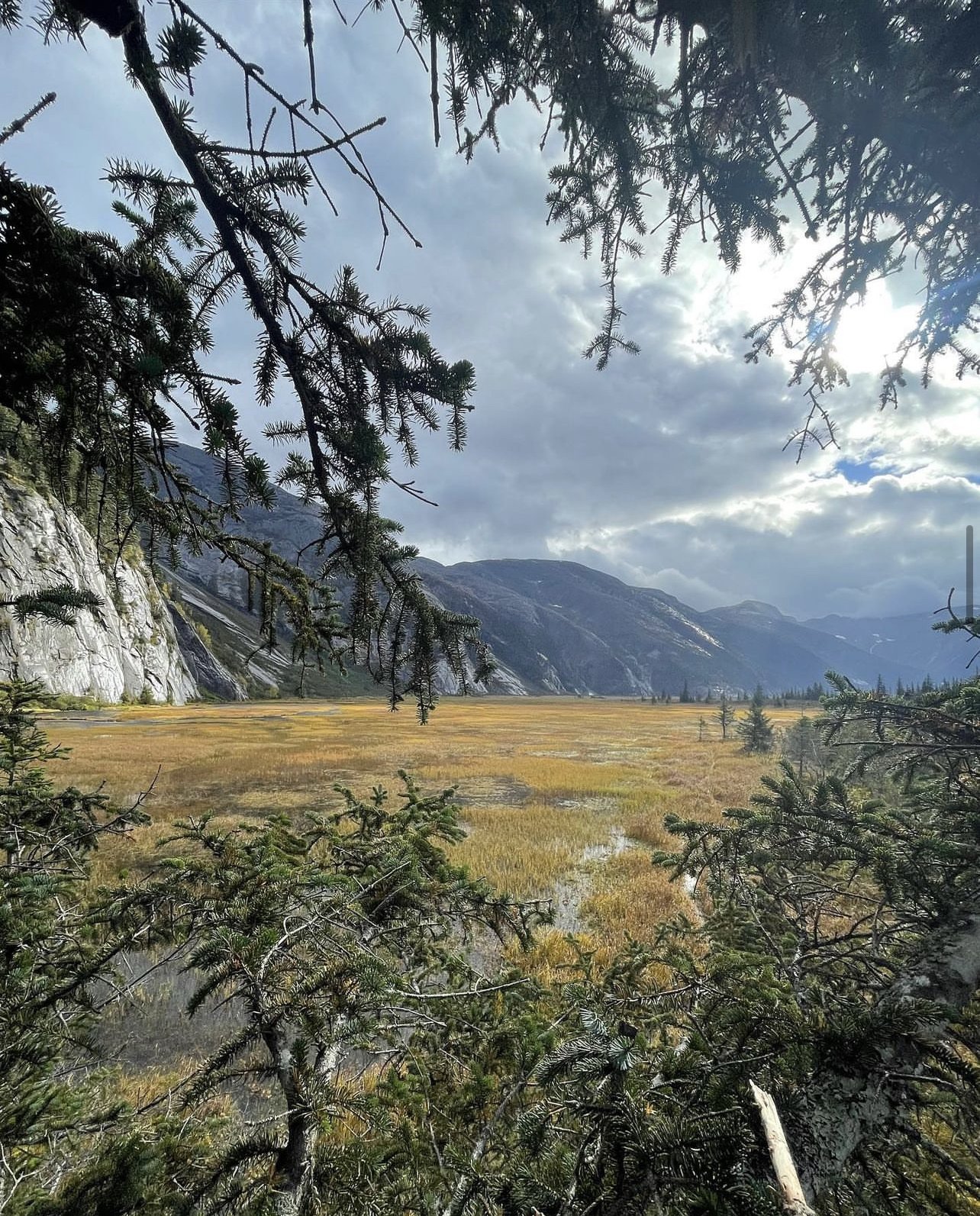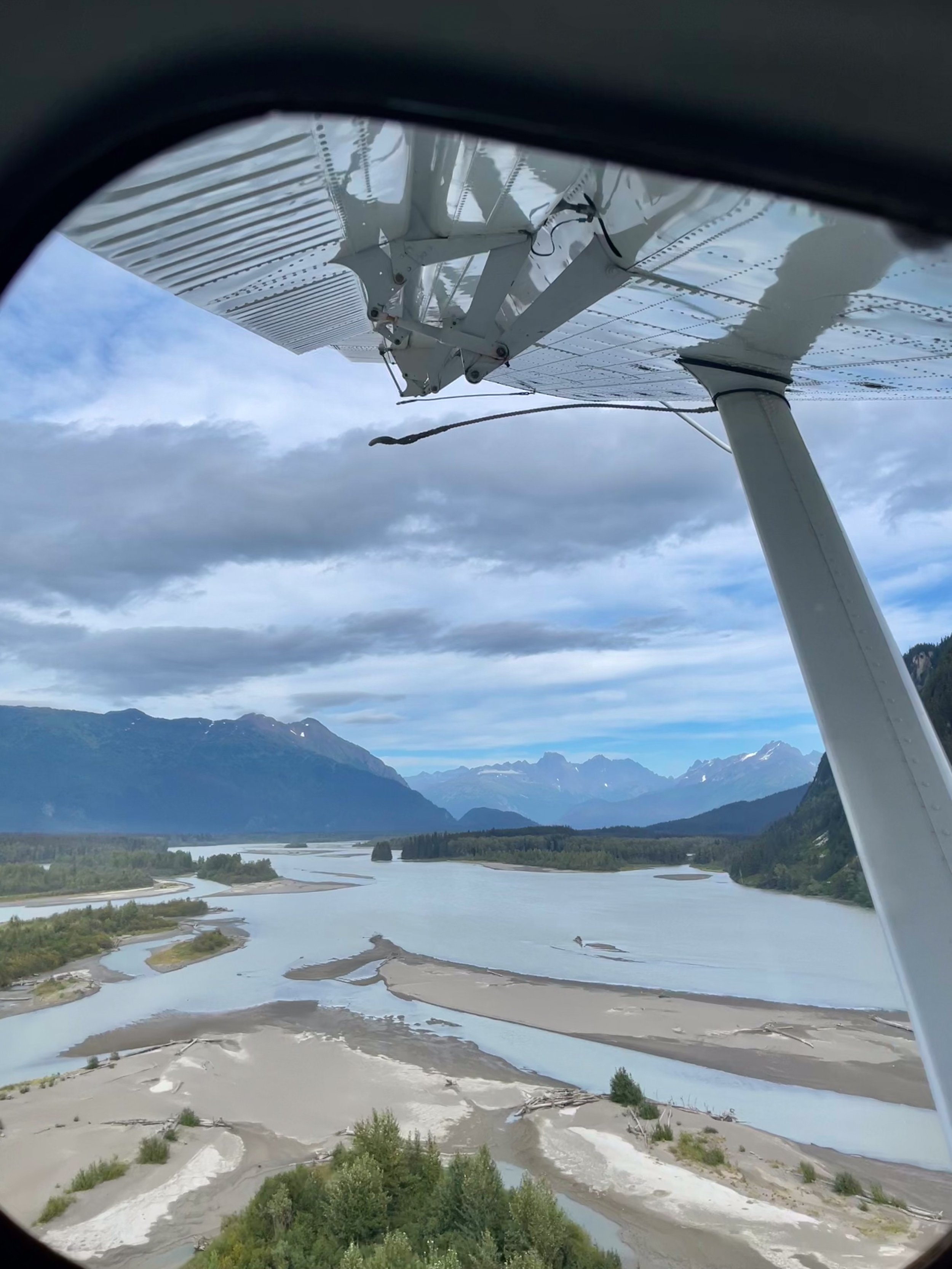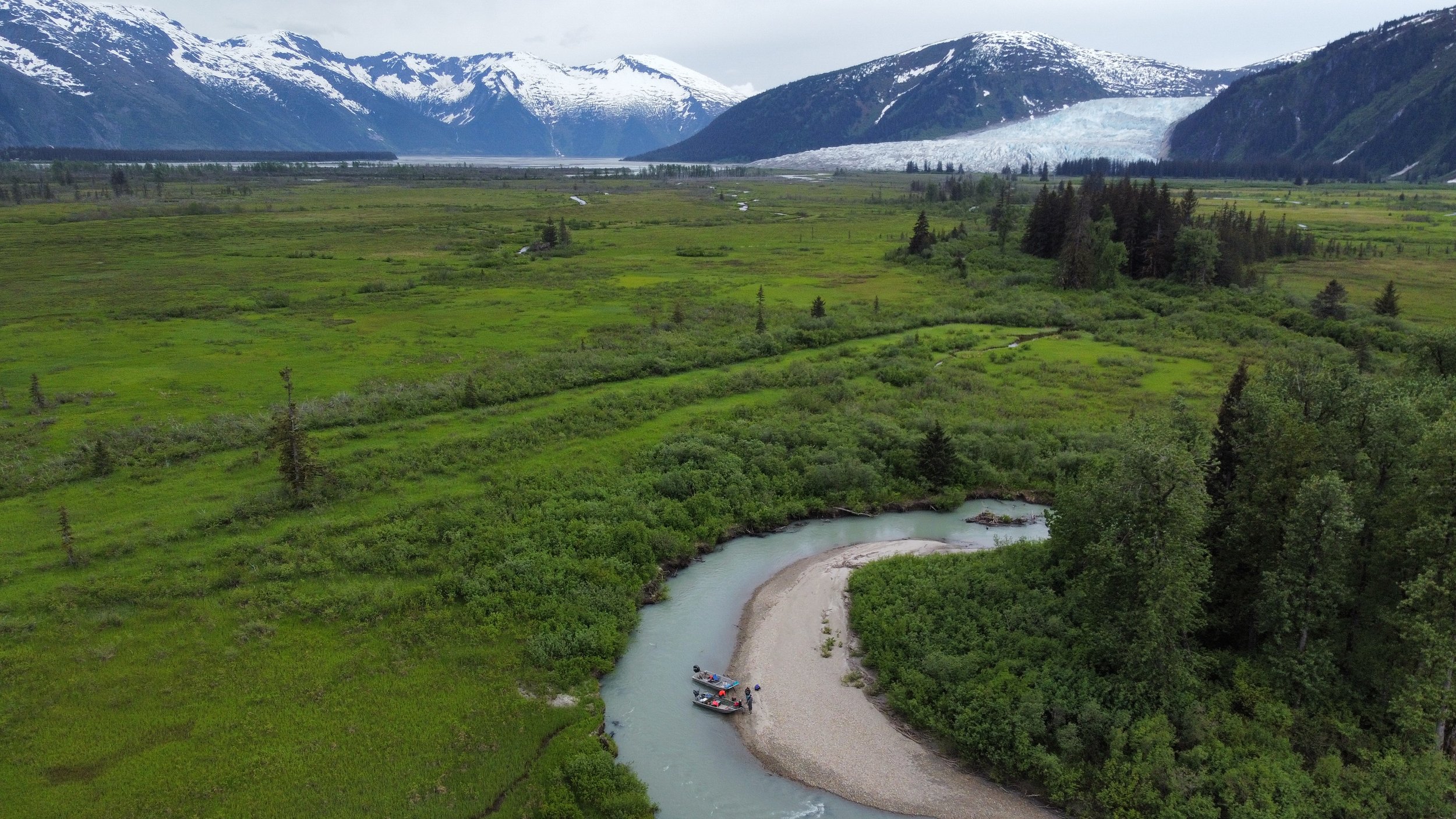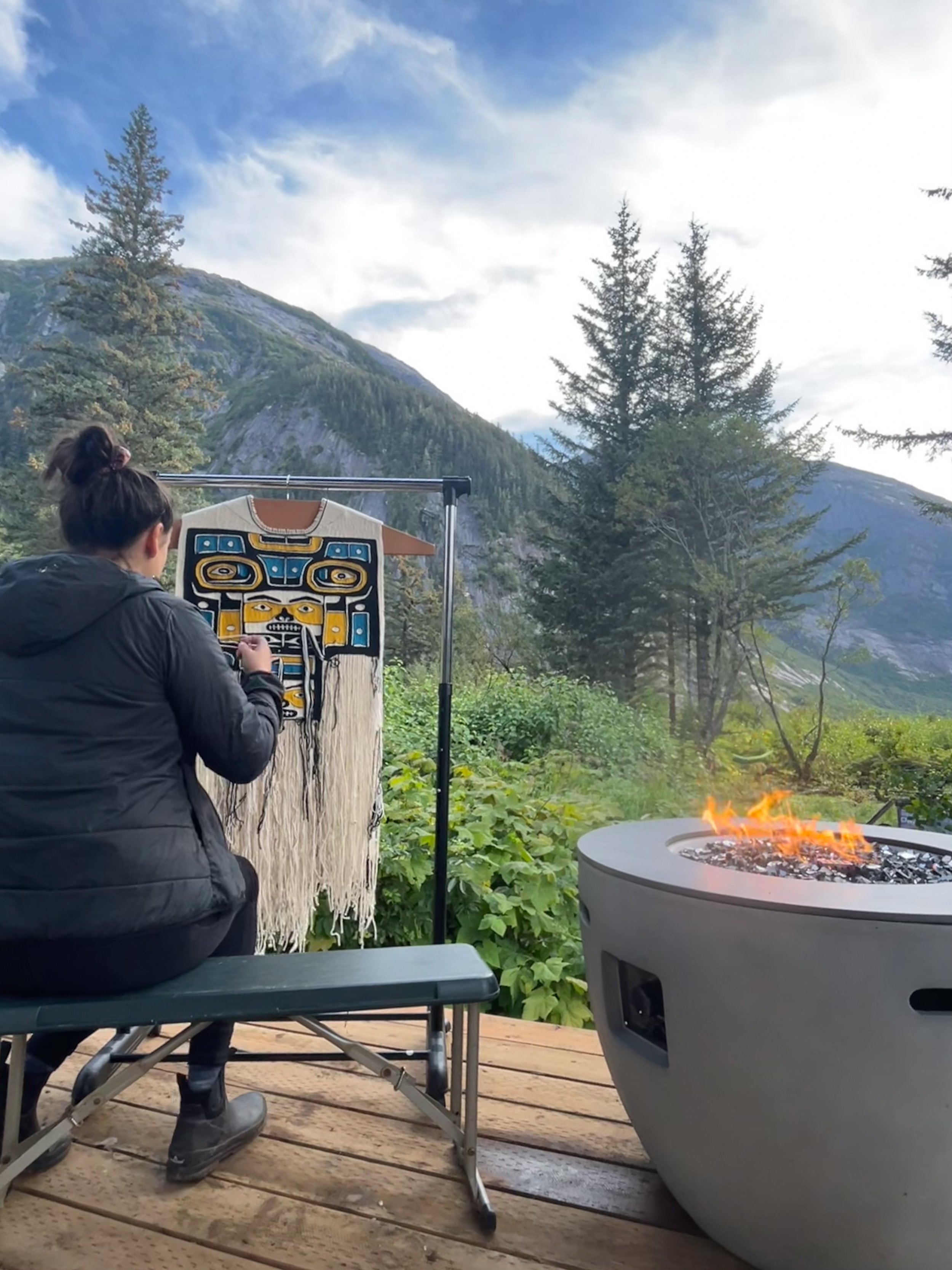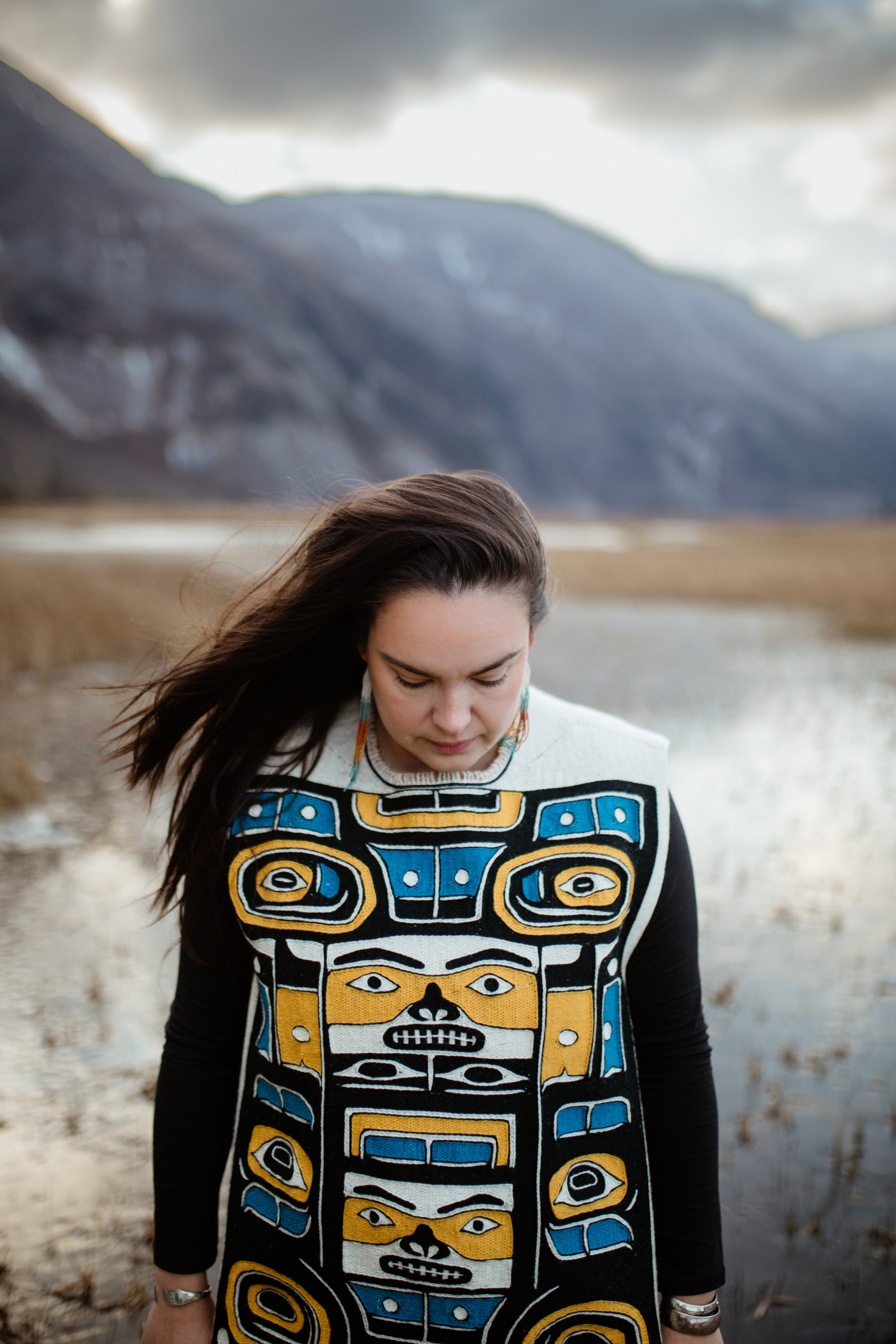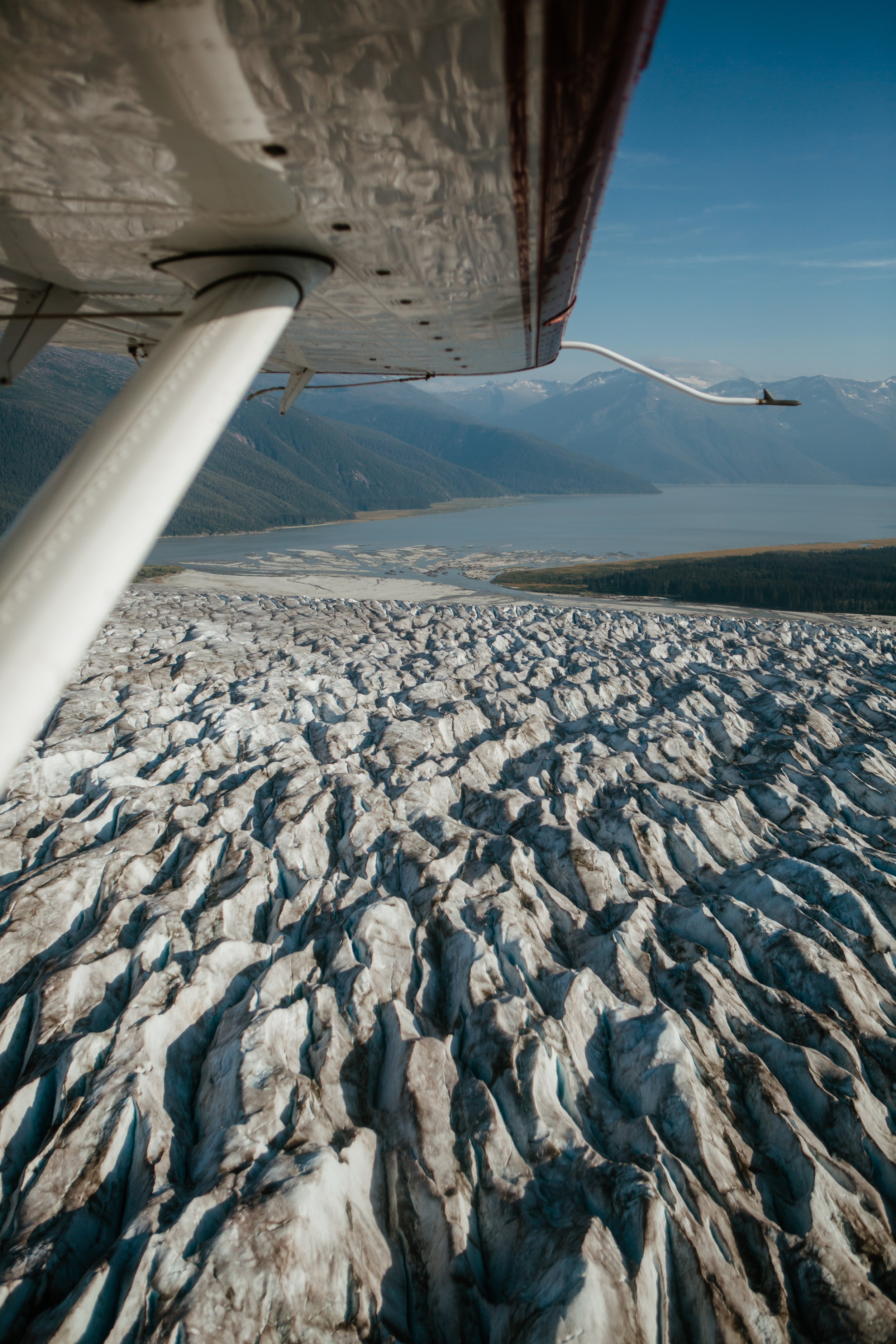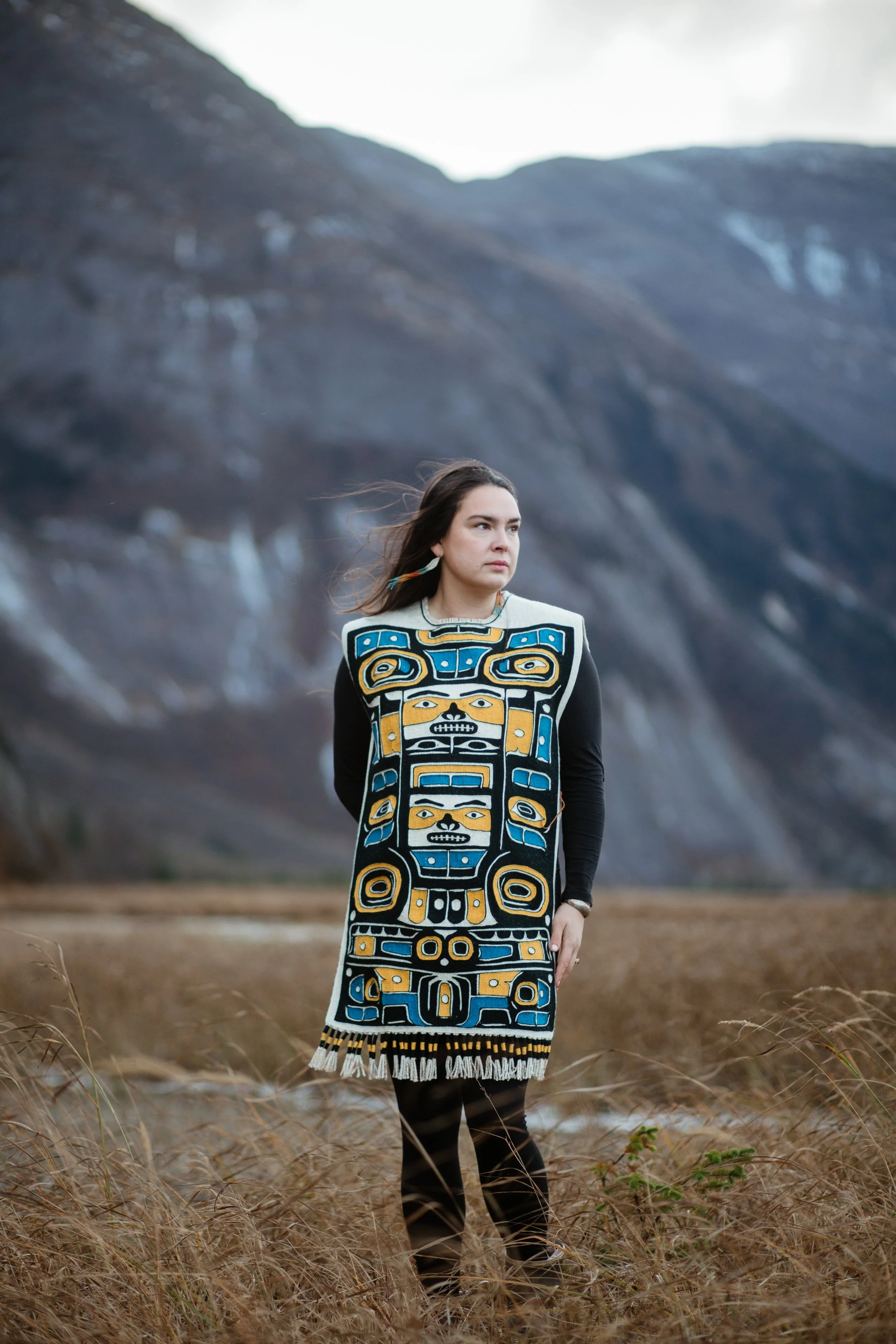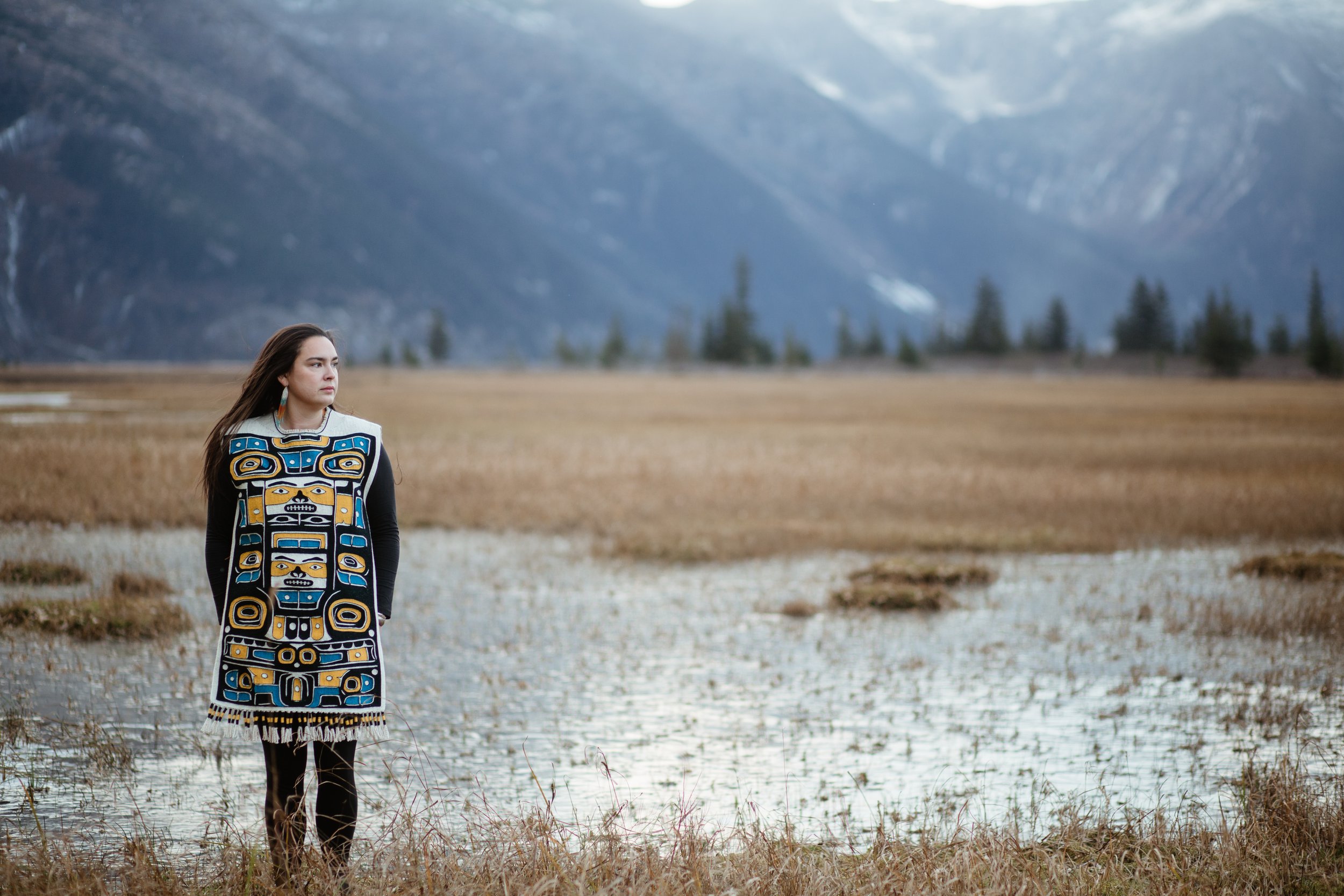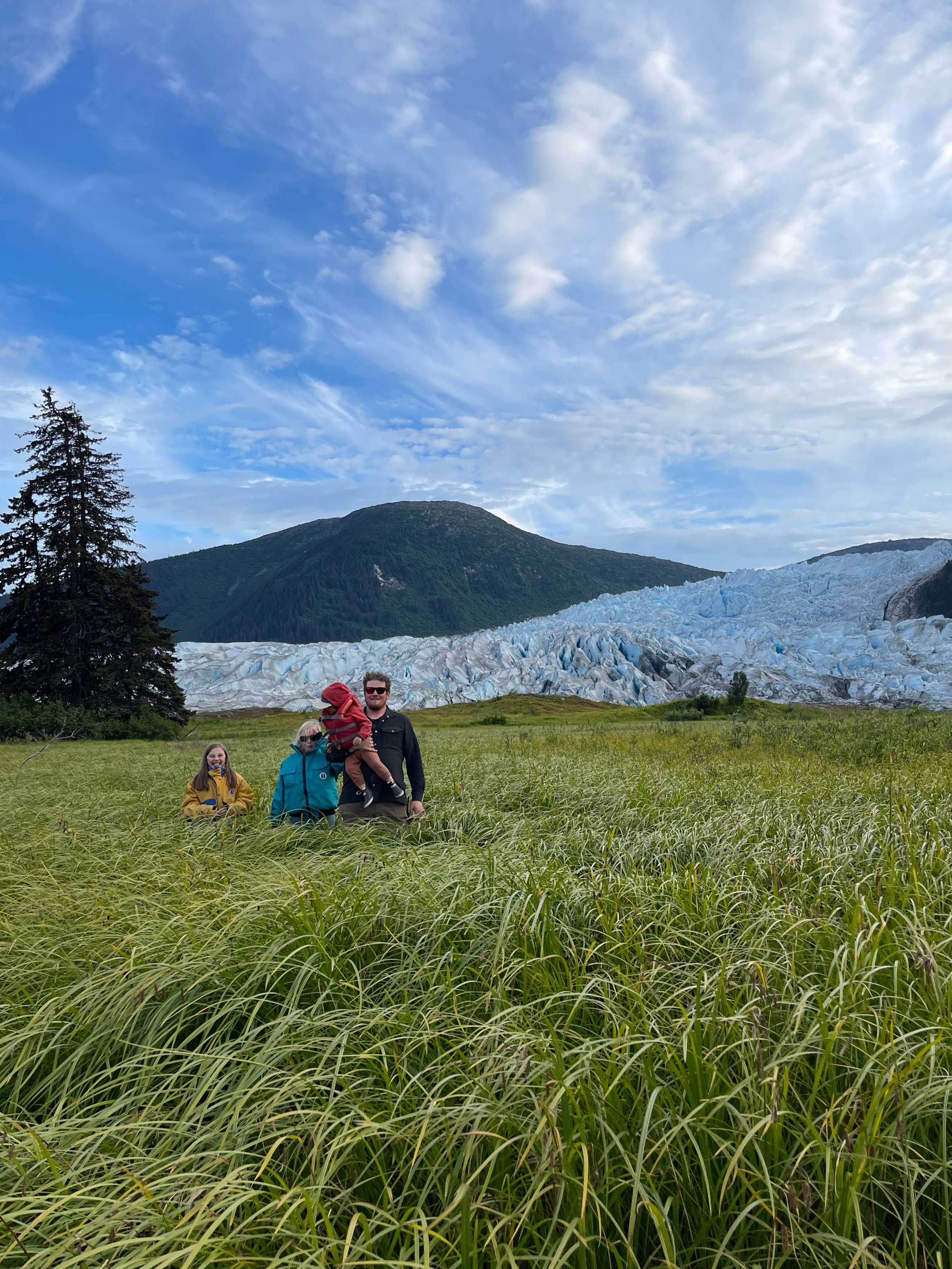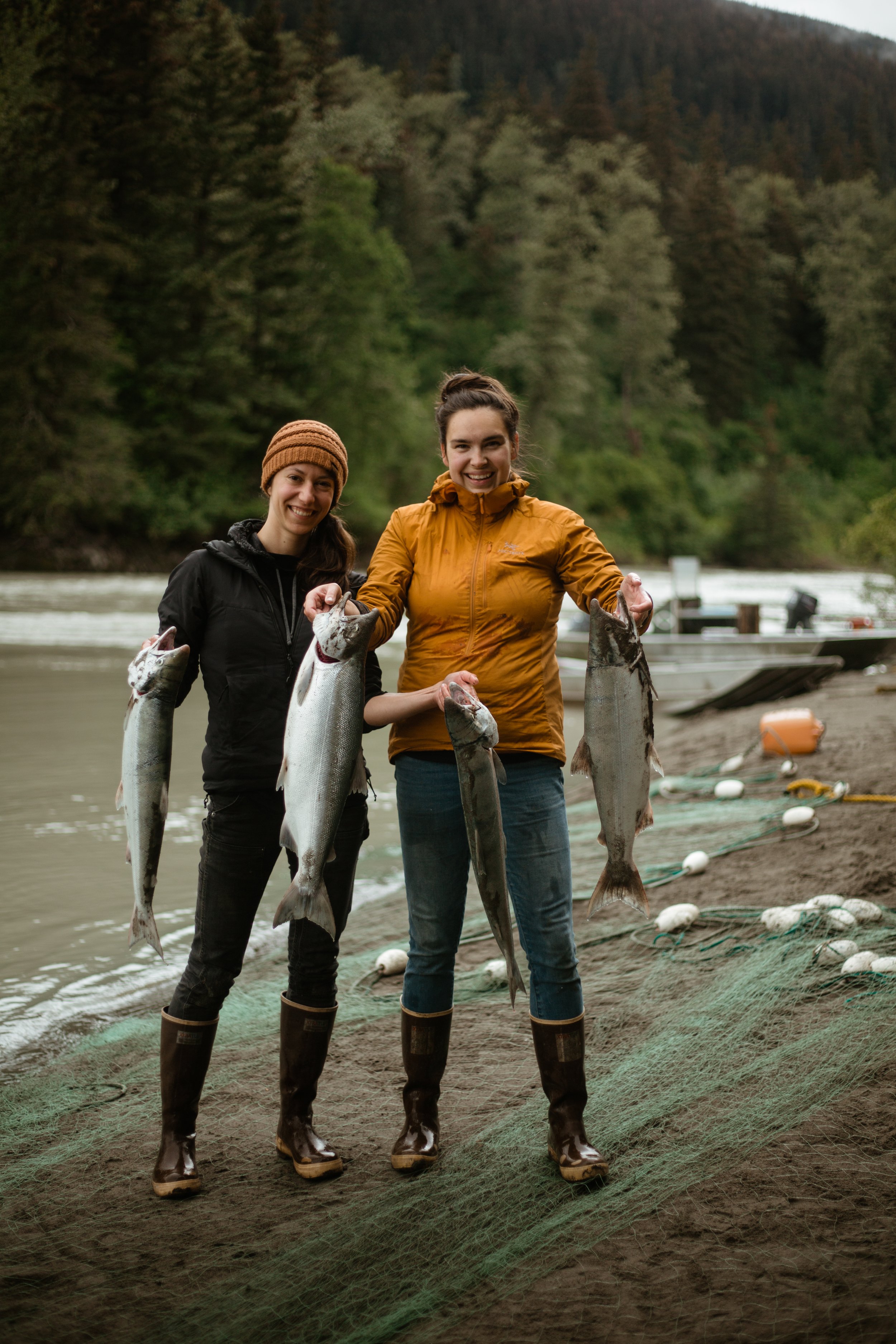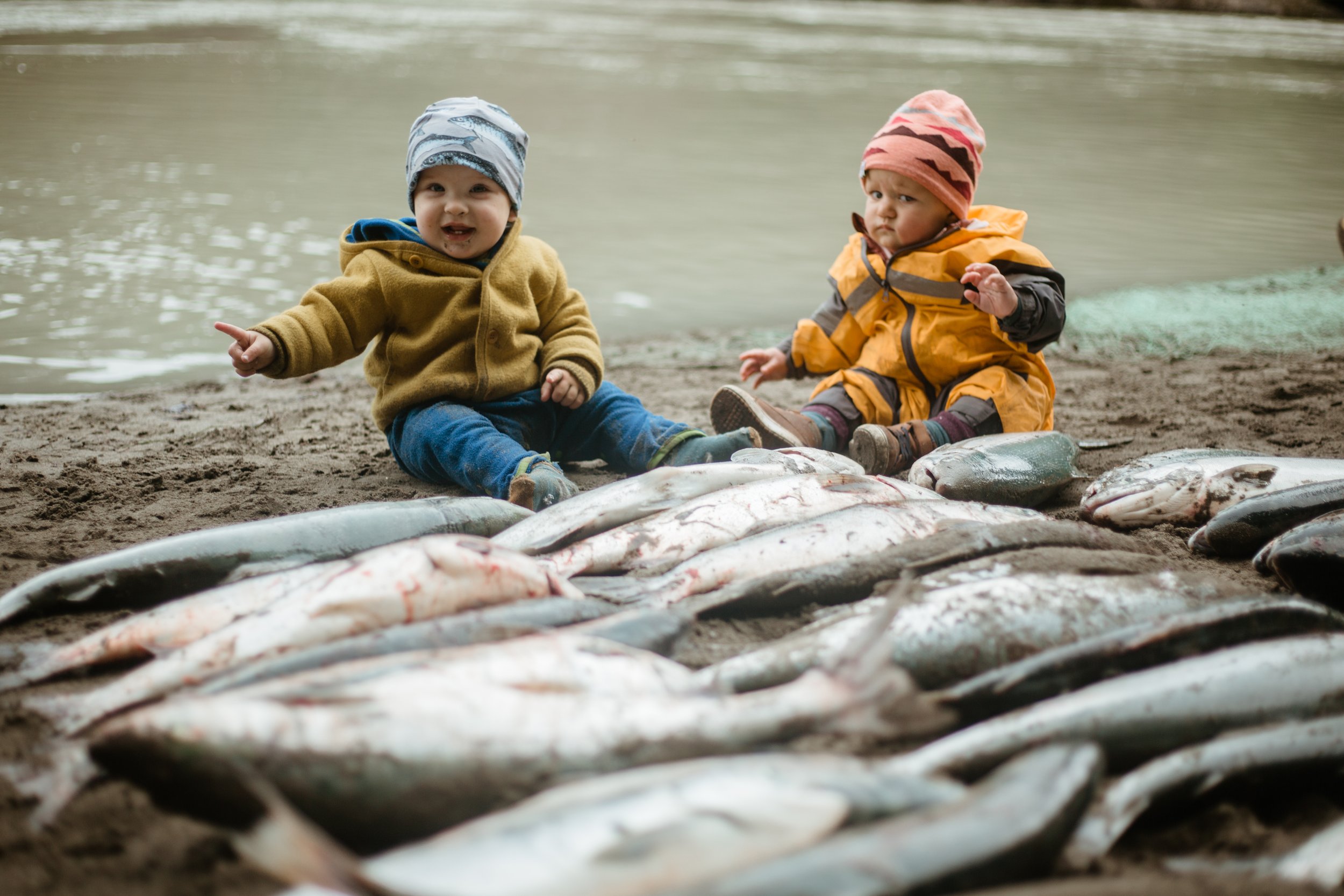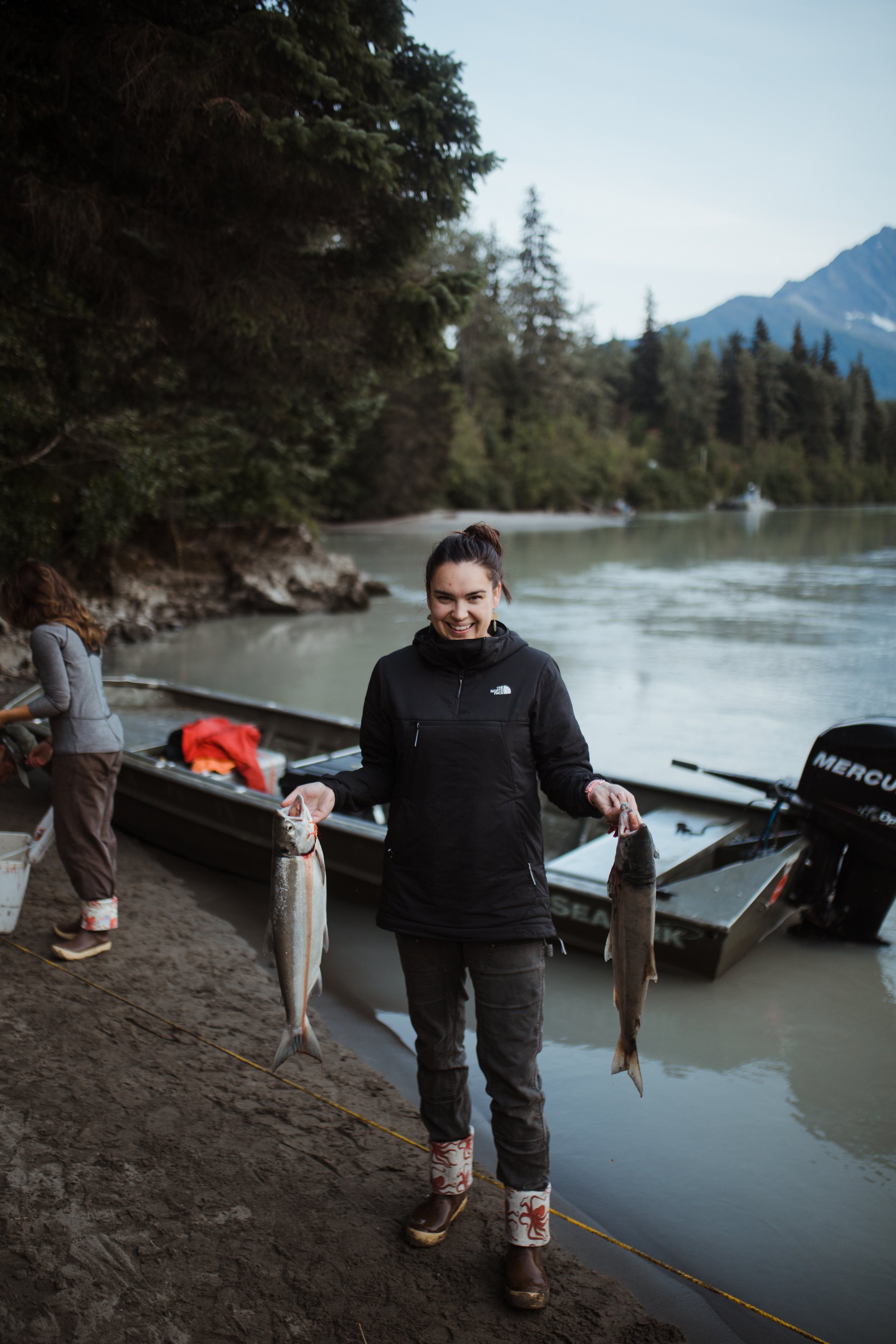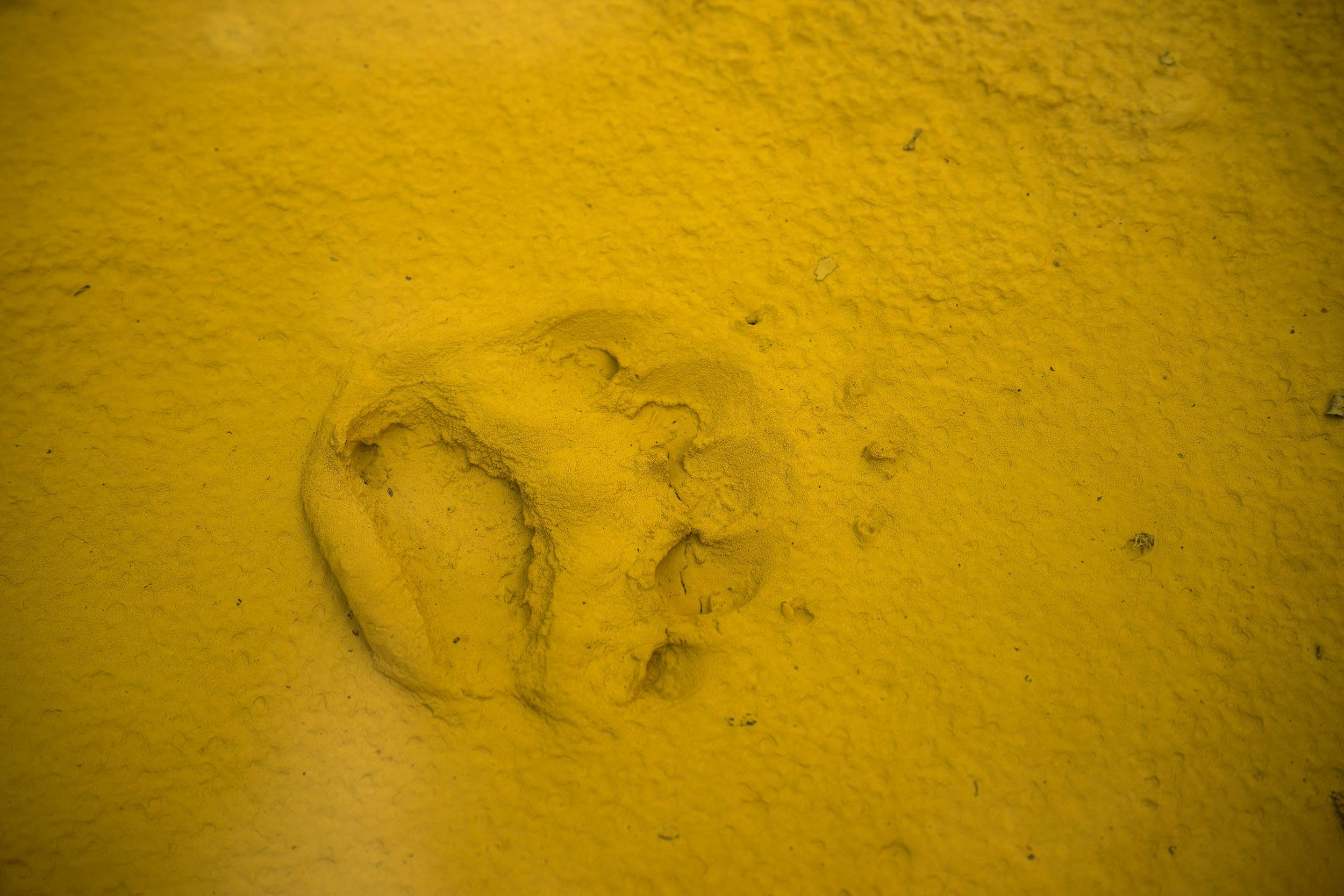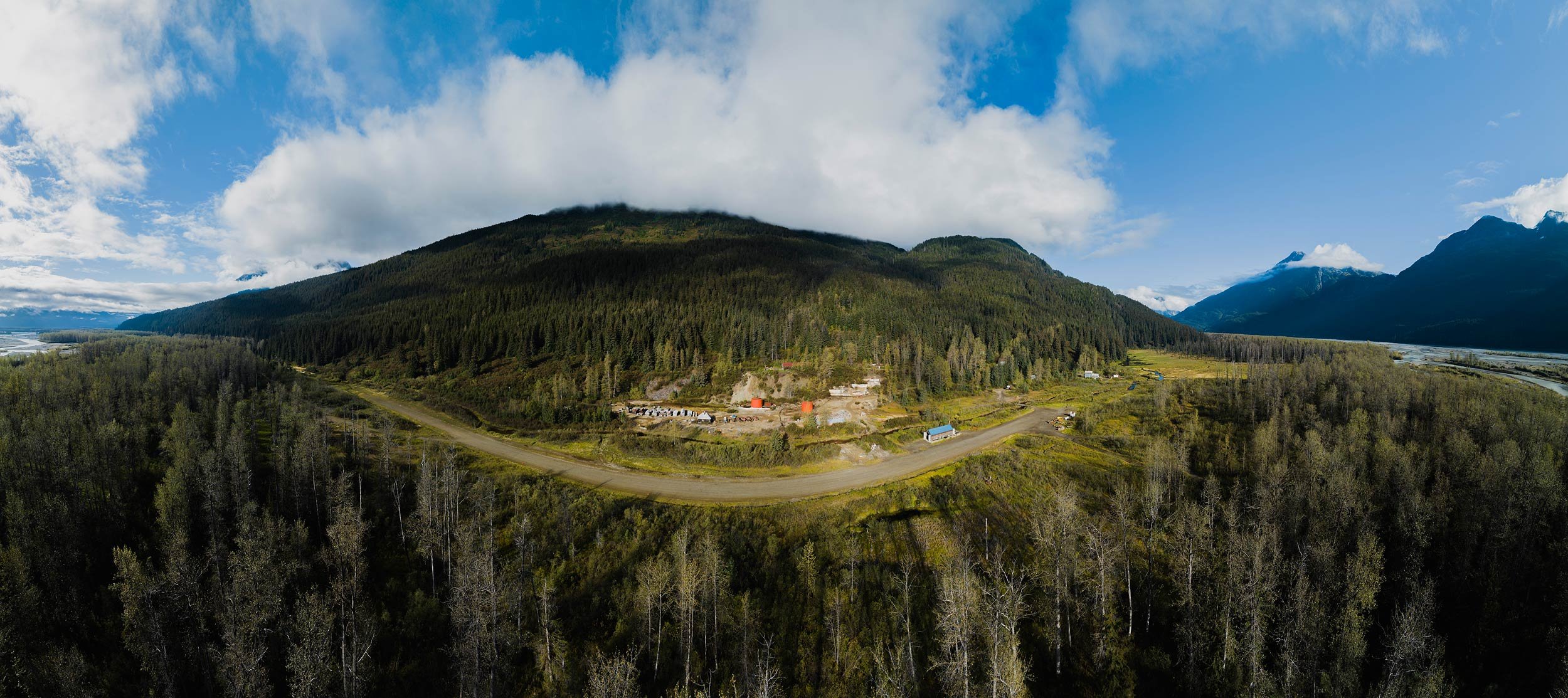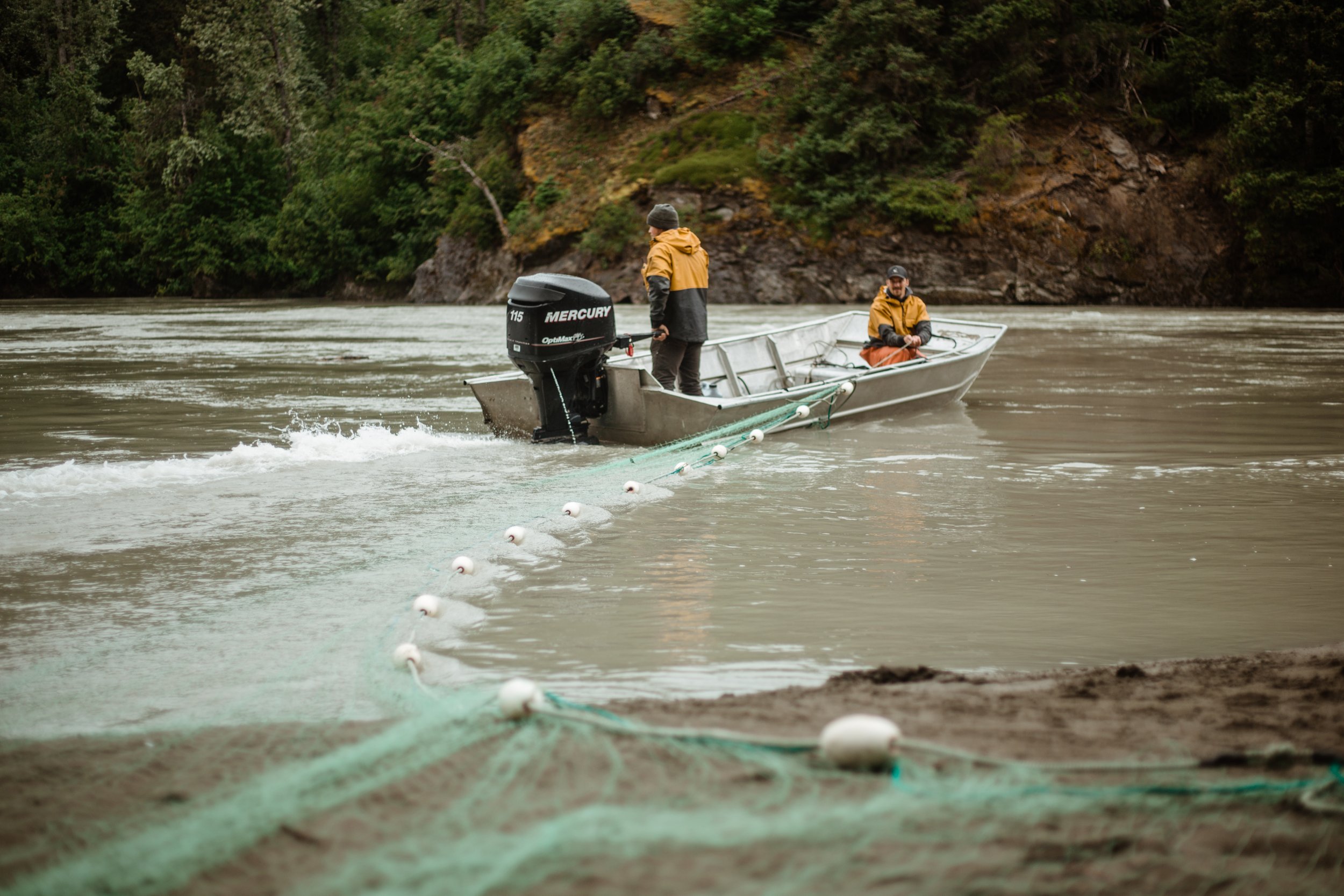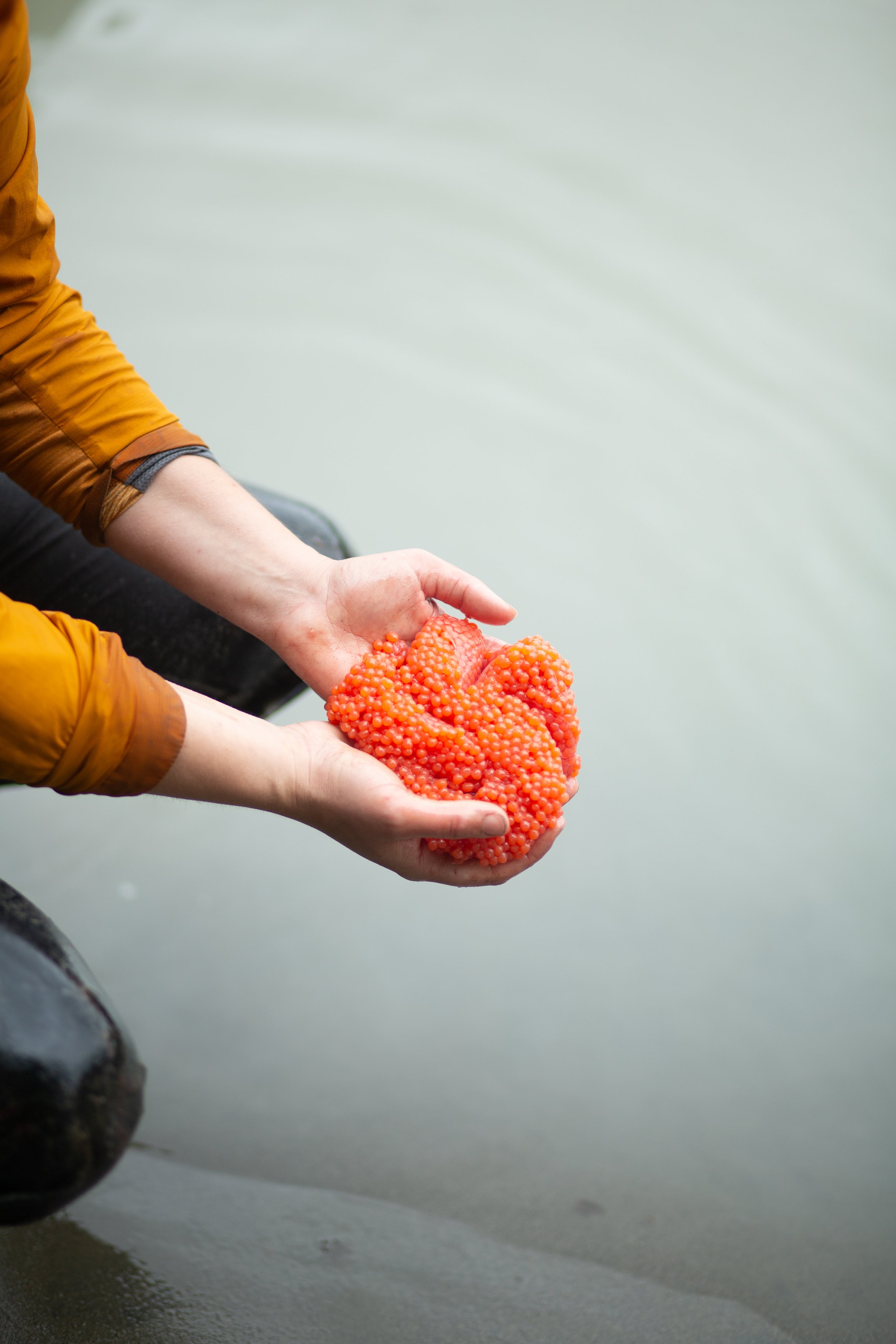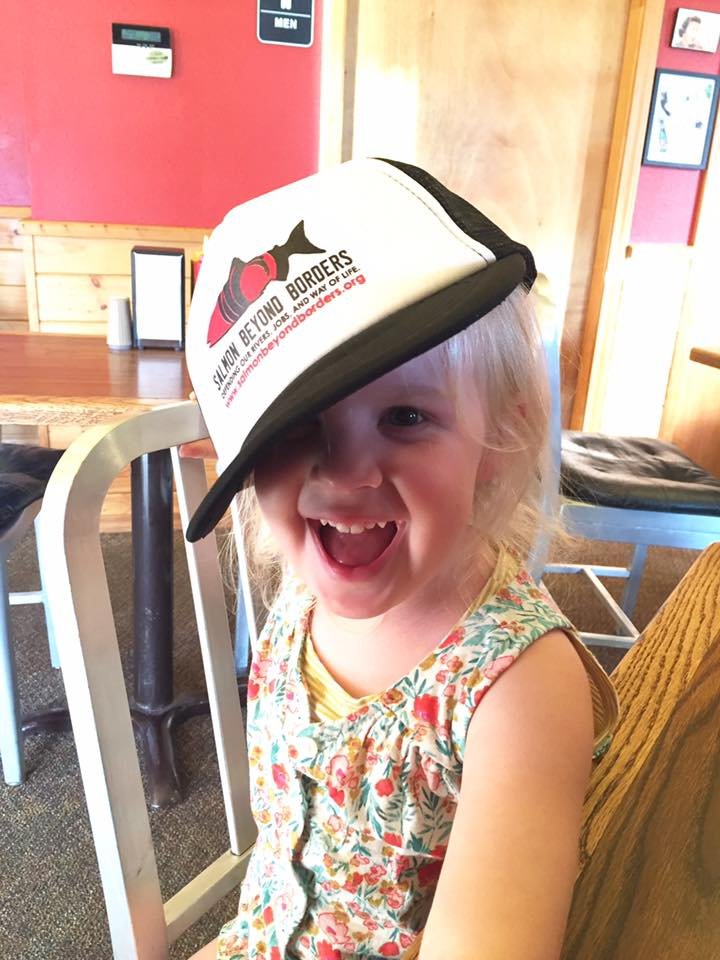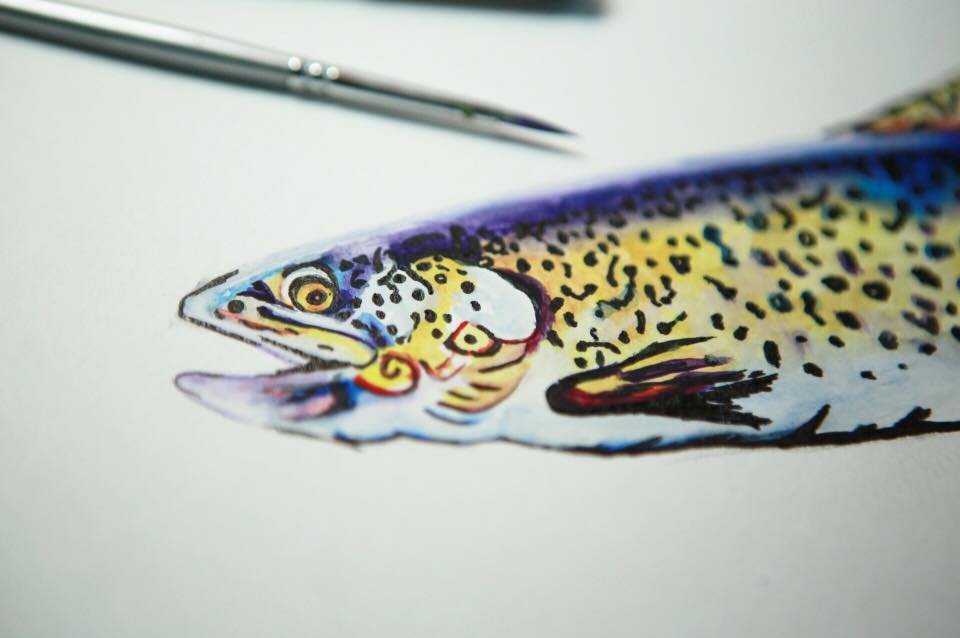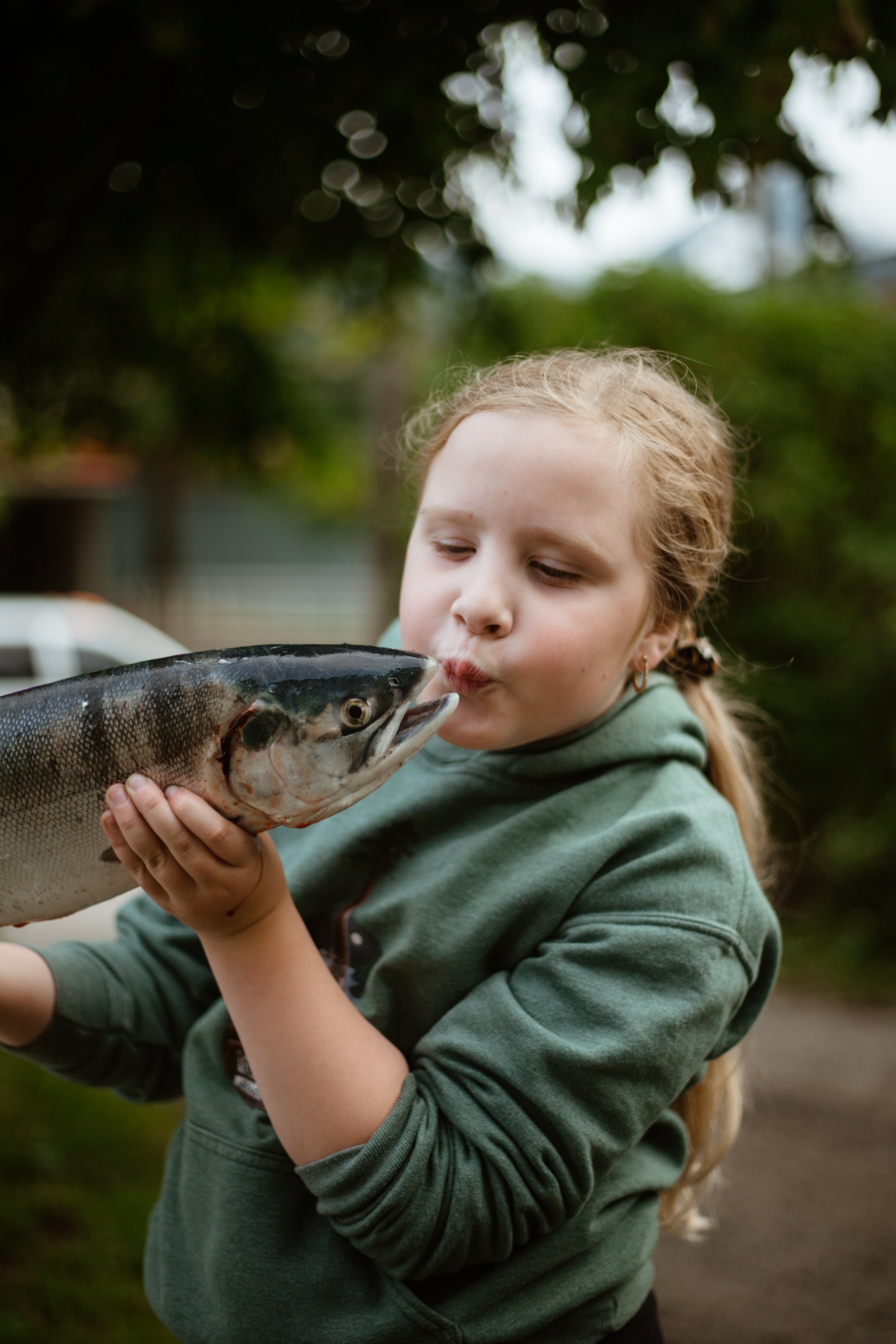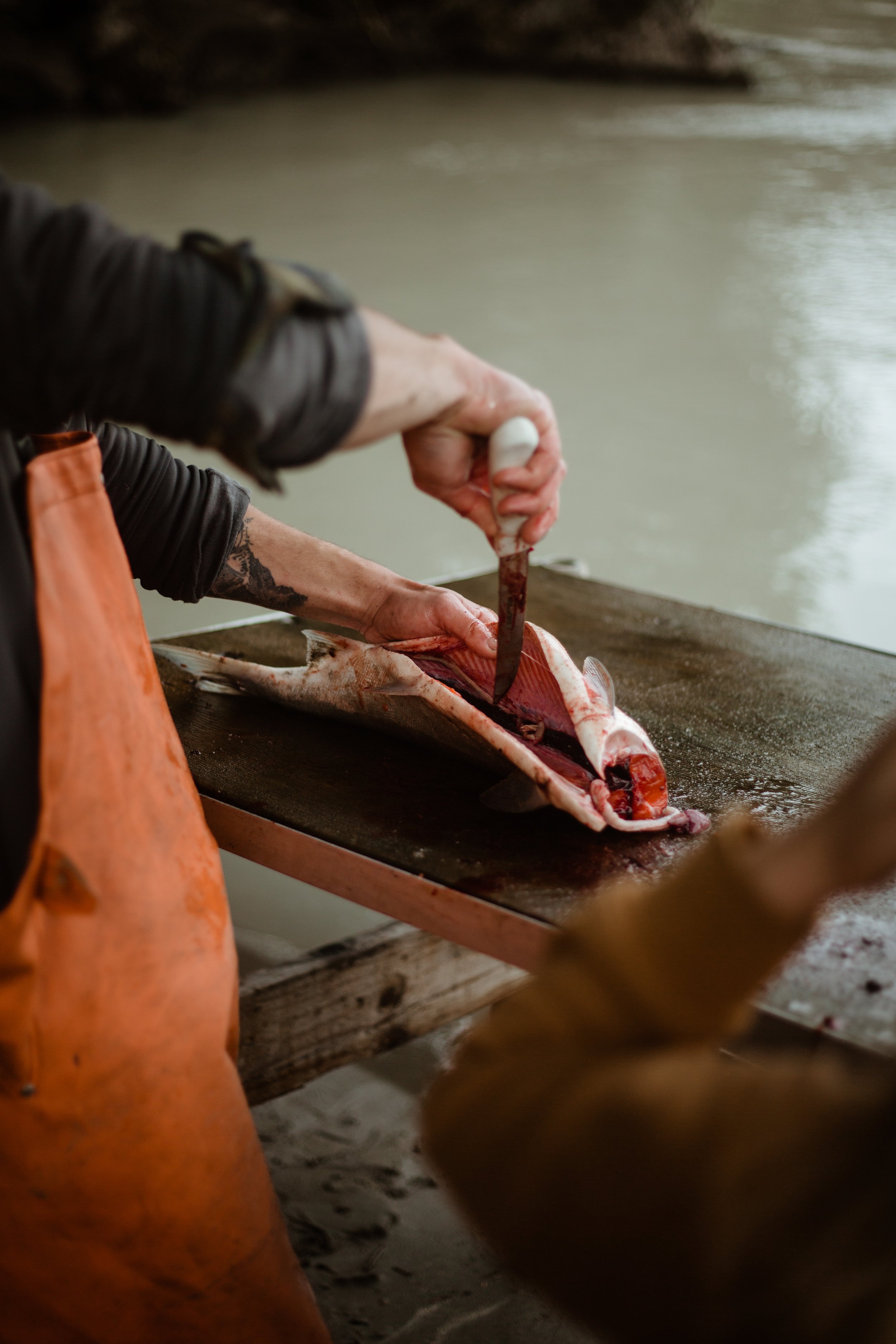Sydney Akagi
Photos by Sydney Akagi
“Growing up I spent a lot of time on the water fishing with my dad and my grandpa in the waters around Juneau. I have a lot of memories of time spent on the boat waiting for a fish to bite, getting seasick, and processing fish. As I got older and in my teenage years I didn’t have as much interest in fishing, but continued to spend a lot of time on boating adventures with family and running around with cousins casting and setting crab pots.
Then, in 2011, I moved back to Juneau after attending college in Colorado and began working with a friend on multiple women’s fly fishing films, since then fishing has been a big part of my life. My husband and I, along with our kids and my cousins who I’ve been fishing with my whole life, subsistence fish for sockeye every year. Whether it be up Taku or Sweetheart creek, it is one of our most looked forward to, and loved seasons!”
—Sydney Akagi, Chilkat and Ravenstail weaver, photographer
Photos by Sydney Akagi
“As a kid, we would go up to Turner Lake and go on picnics. We only had an ocean boat, so it was the furthest my parents knew how to navigate up the Taku. It’s been a special place over the years and holds lots of memories of great times and struggles of getting there. From one of my first dates with my husband at West Turner Lake, to failed attempts to reach the trailhead getting stuck in the mud flats. It might be exaggerated in my brain now, being older and having thought about it for years, but one of our first times going up there with my parents, we got out of the boat and into the Zodiac to get to shore, and planted it. We had to stay there till high tide. We couldn't get out, because you would sink down into the mud and your boots would stick. So we sat there in the mud for what felt like an entire day, but it was likely only a few hours. We gave up and never made it to the lake on that trip. As a kid, the memories feel warm, full of laughter with my family, surrounded by incredible views of fjord-like walls and this crazy blue water. We love getting up there for trout fishing — some of the largest cutthroats I’ve ever caught have been in there. Turner Lake is one of my family’s favorite places in the world.”
—Sydney Akagi, Chilkat and Ravenstail weaver, photographer
Photos by Sydney Akagi
“Before purchasing property up Taku River my husband and I had kind of a 10-year plan to buy a property up Taku. But in 2021 we were lucky enough to purchase our property from a family friend before we ever expected. Since then we've just been there nonstop. Our two kids, ten and two years old, love it there. It's a struggle to convince them to leave on weekends.
We are still building, and dreaming of future plans to become as sustainable as possible so we could spend the full year up there. We have plans for greenhouses, and I love researching about freeze drying food preservation, and how we could apply that to harvesting from the land and growing other food. This summer the kids and I never did anything with our strawberries we picked. They barely made it back to town before we ate every last one of them. We got all of our sockeye in July — smoked and jarred all of it, and I find myself rationing it through the year so I don’t run out before the next July.
Whereas fishing is my season, my husband lives for moose season up the Taku. Coming from Juneau where we don’t have moose, it’s been wild living among them. Very early summer mornings at the cabin I wake up routinely at the same time to see the same moose cross through our property or run through the meadow. It's magical.
I love so many things about the Taku River. it becomes so much of your life, and identity.”
—Sydney Akagi, Chilkat and Ravenstail weaver, photographer
Photos by Sydney Akagi
“There are so many things I love about the Taku River. For starters, watching my kids grow up running around the Taku River is the best. If we could live up there full time, we would be up there today. I love being out of cell phone range, and getting away from the demands of work. That's huge for me. The fishing is incredibly important for our family. What I catch and process not only feeds my family, but my grandparents, parents, and friends. During sockeye season I am also photographing weddings, and always end up smelling like the smoker when I arrive. I religiously have the week we fish blocked off in my calendar from here until eternity. It’s a hard week of processing once we get back from fishing, but it’s my favorite week.
My kids love to help with fishing, fileting and processing as much as they can too. Our daughter is always there helping, pulling fish from the nets, fileting, washing, and even studying the parts of the fish. She understands how important it is to our family and we spend a lot of time teaching about being respectful of the fish and giving thanks to them and the waters they came from.
We also have an incredible community of friends up there. Our kids are all best friends and we find ourselves together all the time when it's not river season, talking about the next summer.
Being able to explore is just so amazing. And it’s a different climate, a little bit drier on the other side of the mountains. The berry picking is huge. There’s so much to see up Taku River.”
—Sydney Akagi, Chilkat and Ravenstail weaver, photographer
Photo by Sydney Akagi
“In 2018, while working for Sealaska Heritage Institute, I was helping out with a juried art show at the JACC. It was there I became enthralled with a Ravenstail headband on display. Ravenstail predates the well known Chilkat weavings many people are familiar with today, and has many geometrical patterns. I was blown away by it. I instantly fell in love with it. Shortly after I took a course with my mentor Lily Hope and was hooked. I felt very compelled to continue weaving every idea I had, and I would study every piece and book I could. Then in January 2020, Lily convinced me to take the leap to weave full time. Since then, with Lily’s support and teachings, I began weaving Chilkat and have had the support of many grants to weave more substantial pieces.”
—Sydney Akagi, Chilkat and Ravenstail weaver, photographer
Photo by Sydney Akagi
“What I've really loved about weaving is that it's also been a healing journey for me. Growing up in Juneau, I found it hard to be proud of my culture without being criticized.
But then I attended Fort Lewis College in Durango, Colorado, where the school had incredible opportunities for its Native students, and I was surrounded with supportive peers who helped me reclaim my identity. After college, I began working in Indian healthcare and left that for a career that allowed me to work on projects that brought back endangered traditional art forms, such as spruce root basket weaving and mountain goat horn spoons. It was during this time I moved into weaving and found that my weaving not only connected me to my culture but also to the land. Traditionally the materials are harvested mountain goat wool, cedar bark, and dyes made from natural materials such as wolf moss. All parts are both time consuming to harvest and process into the materials ready to weave. Chilkat weaving itself is also incredibly time consuming. Full size pieces take up to a year and 1000+ hours to complete, so it's taken me from a fast-paced life I had been living in Juneau, to a slower, more intentional pace — a pace I find myself living up the Taku River. I now find myself weaving on the front porch of my cabin overlooking the mountains, and meadows, or inside next to the fire, often thinking about how the Taku River is the ancestral lands of the Taaku Kwaan and their fishing grounds. I think about what woolen weavings might have been in this area in the past, or how the fish caught in summers fed the women who worked on their weavings throughout the year. This connection to this area I get to live, and through my art has been incredibly healing and powerful.”
—Sydney Akagi, Chilkat and Ravenstail weaver, photographer
Photos by Sydney Akagi
“Being Tlingit, with my ancestors being from Southeast Alaska, I love to think about how the rivers were also transportation methods. Oral history tells us a story of the migration from what is now known as Canada to Southeast Alaska. The story says the clan observed how the water would flow into the glacier and wondered where it led. Eventually an elderly couple volunteered to take a canoe and follow the waterway into the glacier. So the couple took off while the clan waited. Finally one day the people saw them returning over the top of the glacier. The couple reported back that the water was swift under the glacier, but safe, so the clan all made their way through the glacier to the other side. To this day I love the idea of this happening on the Taku River, but some oral records tell us it was likely the Stikine river.
As in that journey though the river, I feel like our first river trips in the spring are also like going into the unknown because the course we take has changed from the previous year, as rivers do. These trips can be nerve-wracking but they are also exciting for me because we often see mountain goats down on the river in those early trips. In Chilkat weaving, traditionally done with mountain goat wool, these mountain goats are ideal for weaving with their winter hide. We watch these goats take their own journey on the river, following the snowline from the water up to the peaks.”
—Sydney Akagi, Chilkat and Ravenstail weaver, photographer
Photos by Sydney Akagi
“We have a bingo checklist in our cabin journal. I write in it every week before we go back up the next weekend. The goal is to actually not fill anything on the bingo card. On this are our obstacles we face. First one — cruise ship waves in the channel, often uncomfortably large and close together. Two — dodging the nets of the fishing boats, a game of finding the buoy and the boat it is attached to. Three — fingers crossed for calm waters at Point Bishop, often our reason for an unexpected delay or longer weekends. Four — avoiding the sandbars. Five — dodging the icebergs. We have a whole checklist. We’ve filled all of them sometimes. We fill none of them other times. But every week, I take note.
With the talk of the Polaris mine and the barge trips, I can’t help but think of a barge in the river being another obstacle and a sixth check. With the struggles that we face already in a 22-foot boat, I cannot begin to fathom how a barge could manage avoiding the ever-changing sandbars or how residents and those who love and utilize the Taku River might avoid a barge in the river. The talk of more than 100 barge trips a year would mean a barge in the river almost the entire summer river season.”
—Sydney Akagi, Chilkat and Ravenstail weaver, photographer
Photos by Chris Miller
“I didn't know about the Tulsequah until I started dating my husband and he would talk about it and say, ‘You would not believe this place. They just left it. You show up, and there’s yellow runoff. I'll take you up there someday.’
I tried to envision it, but it wasn’t until seeing it in person could I fully comprehend the stories.
The last time we went to Tulsequah was about four years ago. When we showed up there it was almost spooky, like a zombie movie scene. There are vehicles, old work gear, containers that were used for offices with papers and everything all over the desk, and the yellow runoff was hard to ignore.
And now, the New Polaris mine and barge plans caused a lot of concern when I first heard about it, based with the experiences I’ve had navigating the river and with first hand experience seeing the Tulsequah mine. Beyond not cleaning up the mine that continues to leak into the river before beginning a new project, the idea of a barge making the trip up the river with cyanide and fuel upstream, and more than 100 trips a year, and a possible accident on the river, could be incredibly devastating to the health of the river that is already struggling, across the border, with what all of us downriver can’t control.”
—Sydney Akagi, Chilkat and Ravenstail weaver, photographer
Photos by Sydney Akagi
“The health of my family, and of the water is my biggest concern right now. Contaminated water is flowing out beyond the rivers into our oceans. The river is home to the fish we love so much, and the water that sustains the life of the animals in the Taku River valley.
I worry about how we are leaving this land and water, and its inhabitants for our kids and future generations. When water gets contaminated so quickly and there's no containing it., and it becomes incredibly difficult to clean up.
Taku River is such a sacred place for us. We spread my husband's mother's ashes up there, and before I had my son, I read an article that told how tribes used to plant their placentas because your placenta is like a tree and roots, and it roots you to the land where you bury it. I ended up doing this up the Taku River after I had my son. And I can’t imagine I’ll want my ashes to be anywhere but up there. I feel so rooted to the land.”
—Sydney Akagi, Chilkat and Ravenstail weaver, photographer
Photos by Sydney Akagi
“When we don’t take care of and listen to the land we are on, we miss so much. I think of the things that the Tlingit understood. For instance — sockeye and fireweed designs are often depicted together in art, because when the fireweed blooms, you know the sockeye are coming in. At the time we’re talking, I'm panicking that the sockeye is not open early enough because the fireweed is already blooming.
With weaving, I see the same things. My ancestors came up with incredible techniques to create structure, resilience and beauty with materials from the land. In Chilkat warp the wool and cedar is spun together, making it strong long term, while also the cedar was a natural bug deterrent. Today our signs are all around us that we aren’t doing things to protect the land. We are no longer catching massive salmon. It’s rare to find massive cedar trees. And you're not getting the runs like we used to. We should take this as a sign of our earth asking for help and doing what we can to replenish instead of depleting and damaging its resources.”
—Sydney Akagi, Chilkat and Ravenstail weaver, photographer


